|
Electronic Poster Session
fMRI |
Thursday, 21 June 2018
Electronic PosterfMRI
5438 -5461 fMRI: Acquisition, Contrast & Artifacts
5462 -5485 Analysis Methods: Task-Based fMRI
5534 -5555 fMRI: Connectivity Methods
5556 -5579 fMRI: Other |
| |
fMRI: Acquisition, Contrast & Artifacts
Electronic Poster
fMRI
Thursday, 21 June 2018
| Exhibition Hall |
13:15 - 14:15 |
| |
|
Computer # |
|
5438.
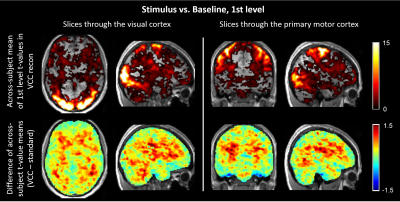 |
1 |
 Using Virtual Conjugate Coil reconstruction for statistical improvement in highly accelerated Simultaneous Multislice fMRI Using Virtual Conjugate Coil reconstruction for statistical improvement in highly accelerated Simultaneous Multislice fMRI
Adam Kettinger, Petra Hermann, Pal Vakli, Martin Blaimer, Kawin Setsompop, Stephan Kannengiesser, Felix Breuer, Zoltan Vidnyanszky
Simultaneous multislice EPI is a popular acquisition method for high-temporal-resolution fMRI. However, at high acceleration factors, significant noise amplification could occur that can hinder the detection of activation. Using the Virtual Conjugate Coil concept, the g-factors of such measurements can be reduced. In this work we investigate the potential statistical improvement of using Virtual Conjugate Coil reconstruction in simultaneous multislice fMRI. Our results show that using Virtual Conjugate Coil reconstruction, first-level and group-level t-values, as well as first-level effect sizes and temporal signal-to-noise ratio are increased.
|
|
5439.
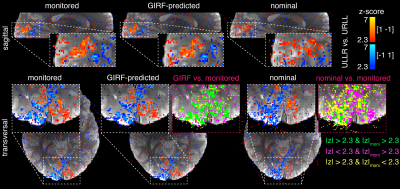 |
2 |
 Spiral fMRI using the Gradient Impulse Response Function for Trajectory Prediction Spiral fMRI using the Gradient Impulse Response Function for Trajectory Prediction
Nadine Graedel, Lars Kasper, Maria Engel, Jennifer Nussbaum, Bertram Wilm, Klaas Pruessmann, S Vannesjo
Image artifacts resulting from gradient imperfections remain a challenge in spiral functional MRI. In this work we reconstructed spiral fMRI data using trajectories predicted by the gradient impulse response function (GIRF). The GIRF-reconstruction generates image quality and fMRI results similar to using a fully monitored trajectory. The presented approach requires only a one-time calibration per system, thus the fMRI acquisition is not prolonged or complicated by the acquisition of additional data for correction purposes.
|
|
5440.
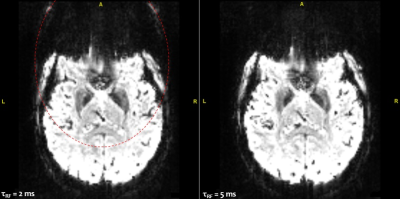 |
3 |
 Gain of temporal signal-to-noise ratio with pTx universal pulses and the whole-brain fMRI 3D-GE EPI sequence at 7T Gain of temporal signal-to-noise ratio with pTx universal pulses and the whole-brain fMRI 3D-GE EPI sequence at 7T
Vincent Gras, Alexandre Vignaud, Cécile Rabrait-Lerman, Denis Le Bihan, Tony Stoecker, Ruediger Stirnberg, Nicolas Boulant
The volumetric 3D-EPI sequence has already shown great promise for fMRI studies due to potentially increased temporal SNR (tSNR) and lower energy demands compared to 2D multi-slice acquisition schemes. For whole-brain studies the tSNR yet can suffer from sub-optimal flip angles due to RF inhomogeneity. Parallel transmission (pTx) has been shown to be a very powerful technology to mitigate these effects but has been barely used in routine due to a cumbersome calibration procedure. Here, we use Universal Pulses to skip entirely the latter step and increase locally the tSNR at 7T in the 3D-EPI GE sequence.
|
|
5441.
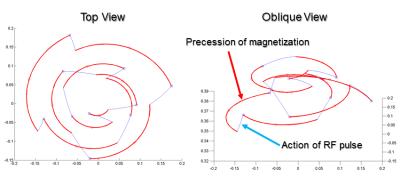 |
4 |
 High SNR Functional MRI Using Oscillating Steady State Imaging High SNR Functional MRI Using Oscillating Steady State Imaging
Shouchang Guo, Douglas Noll
Signal-to-noise ratio (SNR), a limiting factor for functional MRI, can be improved by through the use of higher magnetic fields or through the use of array coils. This work proposes a novel acquisition scheme for BOLD fMRI that has the potential to improve SNR by a factor of 2 or more. This approach uses an oscillating steady state signal that is T2*-weighting and when combined across the period of oscillation produced robust fMRI results in both 2D and 3D imaging experiments.
|
|
5442.
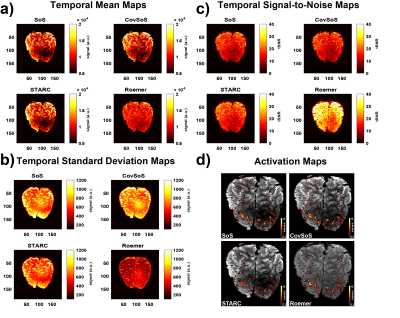 |
5 |
 Effect of optimised coil-combinations on high-resolution laminar fMRI at 9.4T Effect of optimised coil-combinations on high-resolution laminar fMRI at 9.4T
Sriranga Kashyap, Francisco Fritz, Robbert Harms, Laurentius Huber, Dimo Ivanov, Alard Roebroeck, Benedikt Poser, Kâmil Uludag
Despite the availability of more sophisticated coil-combination methods like Roemer and STARC, ultra-high field fMRI studies still use the conventional sum-of-squares (SoS) method for combining the images of the individual coils from multi-channel RF-coil arrays. Here we use a memory-efficient, CPU/GPU accelerated coil-combine toolbox written in Python to compare and characterise the effect of methods such as covariance-weighted sum-of-squares (CovSoS), Roemer and STARC on sub-millimetre resolution GE-EPI laminar fMRI data acquired at 9.4T, and demonstrate the benefit of using optimised coil-combination for UHF fMRI studies.
|
|
5443.
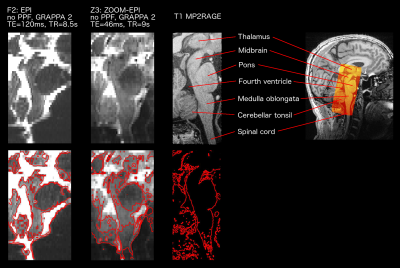 |
6 |
 Distortion-matched high-resolution reduced-FoV functional and diffusion MRI of the human brainstem at 7T Distortion-matched high-resolution reduced-FoV functional and diffusion MRI of the human brainstem at 7T
Giovanni Savini, Fabrizio Fasano, Joseph Whittaker , Letizia Casiraghi, Fulvia Palesi, Gloria Castellazzi, Alessandro Lascialfari, Egidio D'Angelo, Derek Jones, Richard Wise, Claudia Gandini Wheeler-Kingshott
The brainstem plays a key role in the central nervous system, but its proximity to the oral cavity and physiological noise sources constitute major limitations for EPI imaging. We compared image quality from full and reduced-FoV spin-echo EPI sequences at ultrahigh field. Compared to standard EPI acquisitions, reduced-FoV techniques confer considerable benefits for brainstem imaging in terms of shortening TE, increasing signal-to-noise ratio and mitigating distortions. We exploited these advantages for 7T distortion-matched functional and diffusion imaging of the brainstem using ZOOM-EPI. A finger tapping task resulted in significant activations in regions corresponding to the cuneate nucleus and the pyramidal decussation.
|
|
5444.
 |
7 |
 Enhanced fMRI Using a Novel 3D Ultrafast Gradient-echo-based Sequence Using Spatiotemporal Encoding. Enhanced fMRI Using a Novel 3D Ultrafast Gradient-echo-based Sequence Using Spatiotemporal Encoding.
JaeKyun Ryu, Won Beom Jung, Jeong Pyo Son, Seong-gi Kim, Jang-Yeon Park
We recently introduced a novel ultrafast 3D gradient-echo-based imaging technique using spatiotemporal encoding (SPEN), which was dubbed RASE (Rapid Acquisition with Sequential Excitation). RASE has less sensitivity to field inhomogeneities and susceptibility differences compared to conventional multi-slice GE-EPI, sharing the advantages of 3D imaging such as high signal-to-noise ratio and high spatial resolution. In this preliminary study, we present very promising results of RASE-II fMRI, i.e., better t-scores, tSNR, and BOLD percent-signal-changes than conventional multi-slice GE-EPI, on a 9.4-T animal scanner.
|
|
5445.
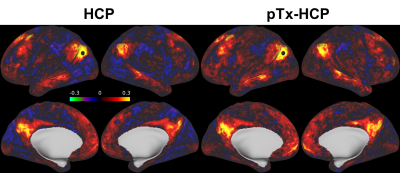 |
8 |
 Human Connectome Project (HCP)-style resting state functional MRI at 7 Tesla using RF parallel transmission Human Connectome Project (HCP)-style resting state functional MRI at 7 Tesla using RF parallel transmission
Xiaoping Wu, Edward Auerbach, Steen Moeller, Pierre-Francois Van de Moortele, Essa Yacoub, Kamil Ugurbil
A major component of the Human Connectome Project (HCP) in the WU-Minn consortium is slice-accelerated whole-brain resting-state functional MRI (rfMRI) at both 3T and 7T. Although providing better contrast and higher spatial resolution, the 7T acquisition is compromised by RF nonuniformity. Here, we demonstrate how RF parallel transmission (pTx) can be used to improve RF uniformity for highly-accelerated, HCP-style rfMRI at 7T with simultaneous multislice multiband approach. Our results demonstrate that the combination of pTx with the 8-channel transmit/32-channel receive coil (Nova8Tx/32Rx) enhanced functional contrast-to-noise ratio (fCNR) in most cortical surfaces and subcortical voxels relative to the original HCP protocol utilizing the Nova1Tx/32Rx in combination with dielectric padding. The enhanced fCNR in turn yielded higher correlation values in seed-based connectivity measures. These results demonstrate that pTx provides significant gains in whole-brain rfMRI employed for defining the functional connectome of the human brain.
|
|
5446.
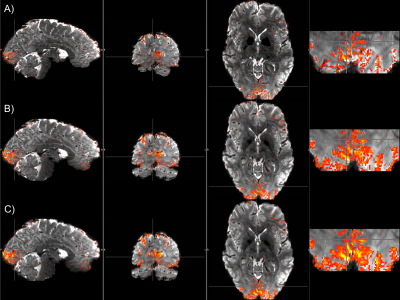 |
9 |
 Dual reconstructions of SLIDER-XD for high spatial and temporal resolution resting state fMRI at 7T Dual reconstructions of SLIDER-XD for high spatial and temporal resolution resting state fMRI at 7T
An Vu, Alexander Beckett, David Feinberg, Pratik Mukherjee
Here we assert that the individual dithers of a SLIDER-XD dataset can be utilized in a dual fashion to reconstruct not only a high spatial resolution dataset but also a high temporal resolution dataset (termed SLIDER-XDT) suitable for fMRI experiments requiring faster TRs. While analogous to spatial smoothing where spatial resolution is traded for statistical power in post-processing, SLIDER-XDT not only provides additional statistical power but also additional temporal resolution which can be used to support detection of additional resting state networks or to temporally un-alias signals of interest.
|
|
5447.
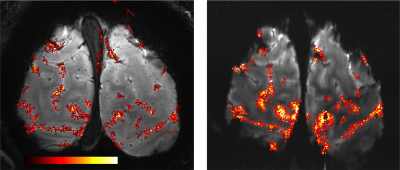 |
10 |
 StImulus Locked K-space shuffling (SILK) for ultra-high resolution fMRI StImulus Locked K-space shuffling (SILK) for ultra-high resolution fMRI
An Vu, Alexander Beckett, David Feinberg, Pratik Mukherjee
Traditional EPI fMRI methods for acquiring sub-mm ultra-high resolution images require longer echo trains, resulting in SNR losses due to longer TEs, as well as, increased blurring in the phase encode (PE) direction, geometric distortion, and susceptibility dropout. StImulus Locked K-space shuffling or SILK-fMRI (e.g. in the context of 3D FLASH imaging) does not suffer from the above limitations but has never before been applied to fMRI. Here we demonstrate the feasibility of SILK fMRI vs. traditional EPI for 0.35 mm ultra-high resolution fMRI at 7T.
|
|
5448.
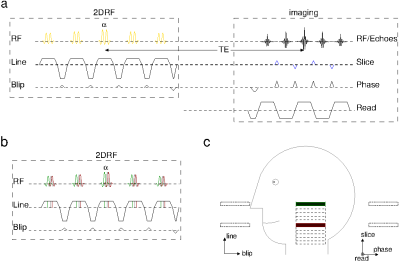 |
11 |
 Multi-Band-Accelerated T2*-Weighted Inner-Field-of-View EPI of the Human Spinal Cord with Slice-Specific z-Shimming Multi-Band-Accelerated T2*-Weighted Inner-Field-of-View EPI of the Human Spinal Cord with Slice-Specific z-Shimming
Jürgen Finsterbusch
T2*-weighted EPI suffers from severe signal dropouts and geometric distortions in the human spinal cord due to susceptibility differences between tissue, vertebrae, and vertebral bones. With 2D-selective RF (2DRF) excitations, the field-of-view can be focused to the spinal cord without aliasing which reduces geometric distortions, shortens echo times, and increases the signal-to-noise ratio significantly. Here, this approach is accelerated with simultaneous multi-slice (SMS) imaging to shorten the acquisition time. An individual temporal shift was applied to the different bands of a multi-band 2DRF envelope which corresponds to a slice- or band-specific z-shim that compensates for the specific through-slice dephasing effects.
|
|
5449.
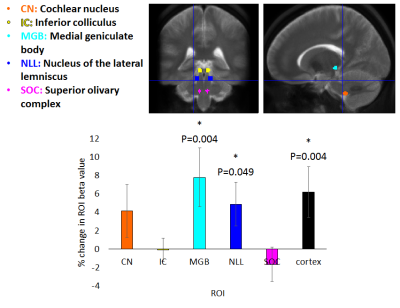 |
12 |
 Optimising the detection of subcortical auditory function using fMRI Optimising the detection of subcortical auditory function using fMRI
Rebecca Dewey, Deborah Hall, Hannah Guest, Garreth Prendergast, Christopher Plack, Susan Francis
We explore the effects of EPI distortion correction and retrospective correction of cardiac and respiratory artefacts on fMRI data quality. Further, we assess the suitability of this data to provide robust detection of subcortical sound-evoked responses for inter-group and subgroup analyses. We report an optimum acquisition, pre-processing and analysis protocol for subcortical fMRI of the ascending auditory pathway.
|
|
5450.
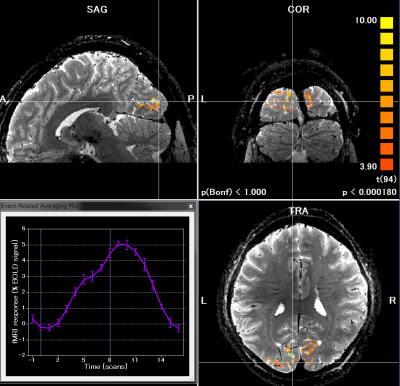 |
13 |
 Block-Interleaved Segmented EPI for voxel-wise high-resolution fMRI studies at 7T Block-Interleaved Segmented EPI for voxel-wise high-resolution fMRI studies at 7T
Guoxiang Liu, Adnan Shah, Takashi Ueguchi
We report a novel segmented EPI method preserving the pattern of hemodynamic response in bock design fMRI studies. The proposed method uses an EPI-based anatomical data obtained with the same distortion from task EPI scans for further fMRI analysis. At sub-millimeter spatial resolution, the proposed method avoids functional to structural registration and spatial smoothing giving us an opportunity to investigate activity dynamics at the columnar level spatial resolution with high specificity. Our results showed that the proposed method can perform voxel-wise high-resolution fMRI studies with a voxel size of 0.6×0.6×0.6 mm3 at 7T.
|
|
5451.
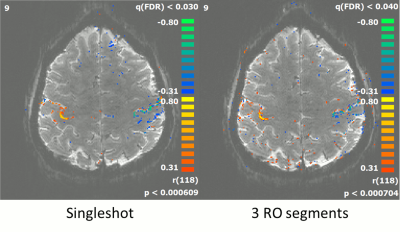 |
14 |
 fMRI with Low Acoustic Noise using Variable-Blipped EPI with Readout Segmentation fMRI with Low Acoustic Noise using Variable-Blipped EPI with Readout Segmentation
Patrick Liebig, Robin Heidemann, Yuehui Tao, Bernhard Hensel, Wei Liu, David Porter
Echo-Planar-Imaging is widely used for fMRI, but generates a high level of acoustic noise This could potentially affect activation power, especially for auditory experiments. One established way to reduce acoustic noise is to use a sinusoidal readout gradient combined with a constant phase-encoding gradient. However, this data-sampling scheme is only suitable for lower acceleration factors. This study investigates an alternative EPI sampling scheme with similar acoustic-noise properties that can be used with high acceleration factors in both phase-encoding and slice-encoding directions. Acoustic noise is further reduced by using readout segmentation to reduce the readout gradient amplitude and slew rate.
|
|
5452.
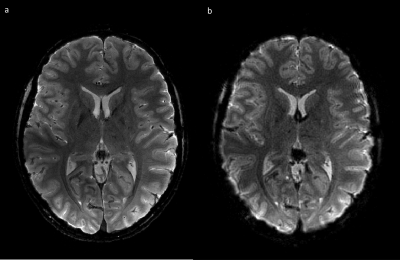 |
15 |
Real-time processing of image and trajectory data: Application to single-shot time series
Did Not Present
Josip Marjanovic, Jonas Reber, Maria Engel, Lars Kasper, Benjamin Dietrich, David Brunner, Klaas Pruessmann
The steady increase in data volume is a significant problem in fMRI time series. Recently proposed signal processing architectures based on digital hardware enable data reduction in real-time before the data are stored. We demonstrate that a high degree of data savings can be achieved with few simple operations. Coil compression and field probe data processing help breaking the data bottleneck in fMRI time-series.
|
|
5453.
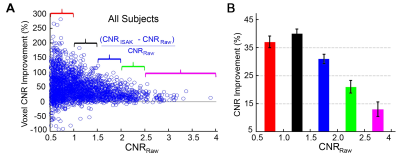 |
16 |
 Enhanced BOLD Contrast-to-Noise-Ratio and Activation Sensitivity with the Intra-shot Adapted Keyhole (ISAK) Method Enhanced BOLD Contrast-to-Noise-Ratio and Activation Sensitivity with the Intra-shot Adapted Keyhole (ISAK) Method
Zhan Xu, Guangyu Chen, Andrew Nencka, Shi-Jiang Li
A fast, multi-echo (ME) fMRI acquisition method, ISAK, is introduced by employing the classic keyhole method in a between-echo manner. ISAK acquires eight echoes within 70 ms, and the associated contrast-to-noise-ratio (CNR) improvement is up to more than 200%. The stronger blood-oxygen-level-dependent sensitivity, compared with regular ME fMRI with four echoes and standard single-echo fMRI without any acceleration, proves the benefit of trading a fraction of spatial samples in each image for more temporal echoes images in improving CNR.
|
|
5454.
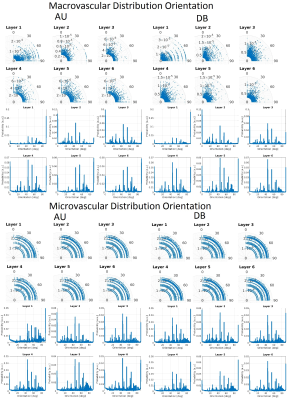 |
17 |
THE ANGULAR DEPENDENCE OF THE GRADIENT ECHO AND SPIN ECHO BOLD SIGNAL INDUCED BY CORTICAL MICRO- AND MACRO- VASCULATURE
Did Not Present
Mario Báez-Yáñez, Philbert S. Tsai, David Kleinfeld, Klaus Scheffler
In recent investigations, the angular dependence of the BOLD signal with respect to the main magnetic field has been shown by Monte Carlo simulations and experimental approaches. This orientation dependence is often attributed to the contribution of large vessels (cortical surface and penetrating arteries/veins). However, the ability to resolve cortical layers and columns depends ultimately on the contribution of the MR signal generated by the capillary bed. In this work, we studied the MR signal attenuation generated by a vascular network model that was acquired from the parietal cortex of mice using a two-photon laser imaging techniques. We separately investigated the impact of macrovessels (>5 µm in diameter) and microvessels (< 5 µm in diameter) on the BOLD effect.
|
|
5455.
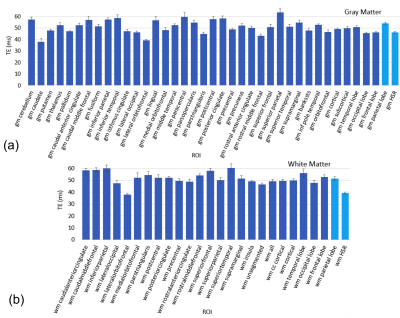 |
18 |
 Regional-specific echo-time optimization in spin-echo EPI at 3 Tesla Regional-specific echo-time optimization in spin-echo EPI at 3 Tesla
Josephine Tan, Don Ragot, J. Jean Chen
Spin-echo (SE) echo-planar imaging (EPI) is less prone to signal dropouts in brain regions of high susceptibility. Such regions are important for the study of memory and language, and have been traditionally difficult to image using the conventional gradient-echo BOLD fMRI. To maximize the contrast-to-noise of SE EPI, echo-time (TE) optimization is critical, and currently, the optimal TE is assumed to be equal to tissue T2. In this work, we use a comprehensive BOLD signal and noise model to characterize the TE dependence of SE-EPI at 3 T. We show that the optimal TE is significantly shorter than the commonly assumed tissue T2.
|
|
5456.
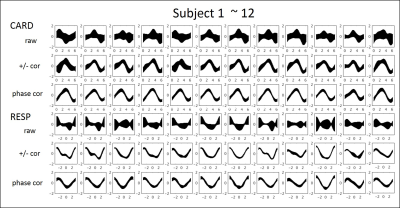 |
19 |
 A comprehensive investigation of physiologic noise modeling in resting state fMRI; phase shifted cardiac response function in EPI A comprehensive investigation of physiologic noise modeling in resting state fMRI; phase shifted cardiac response function in EPI
Wanyong Shin, Mark Lowe
The cardiac and respiratory response functions derived from RETROICOR have substantial variation. In this study, we investigate the source of this variation. We found the cardiac response function is phase or time shifted across the brain while the respiratory function has a fixed phase, but changes polarity across the brain. We further investigated the efficacy of physiologic noise correction accounting for this with a single response function model.
|
|
5457.
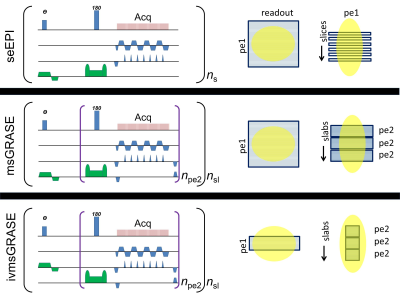 |
20 |
 Novel multi-slab GRASE sequences for fMRI. Comparison with EPI. Novel multi-slab GRASE sequences for fMRI. Comparison with EPI.
Djaudat Idiyatullin, Wei Zhu, Yi Zhang, Xiao-Hong Zhu, Wei Chen, Kâmil Ugurbil
T2 weighted fMRI has been shown to provide higher spatial specificity than commonly used T2* contrast. However, 2D-spin-echo-EPI method, which is the most commonly employed approach, suffers from a low functional mapping contrast. Versions of single-shot 3D-GRASE sequence provide improvements in fMRI contrast, but suffer limitations particularly at ultrahigh magnetic fields due to shorter T2. To solve this problem, a new multi-slab version of the 3D-GRASE sequence with and without the capability of inner-volume selection, abbreviated as ivmsGRASE and msGRASE, respectively, are proposed. The theoretical and practical considerations of these methods in comparison with spin-echo-EPI for fMRI application are presented.
|
|
5458.
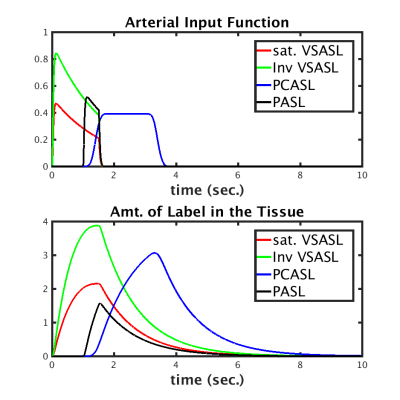 |
21 |
 Velocity Selective Inversion improves the sensitivity and speed of perfusion weighted FMRI Velocity Selective Inversion improves the sensitivity and speed of perfusion weighted FMRI
Luis Hernandez-Garcia, Jon-Fredrik Nielsen, Douglas Noll
This work compares the performance of pseudo-continuous ASL (PCASL) and velocity selective inversion ASL (VSI) for functional MRI using a simple, robust visual motor task. VSI showed increased sensitivity and allowed faster temporal resolution, resulting in further increases in sensitivity.
|
|
5459.
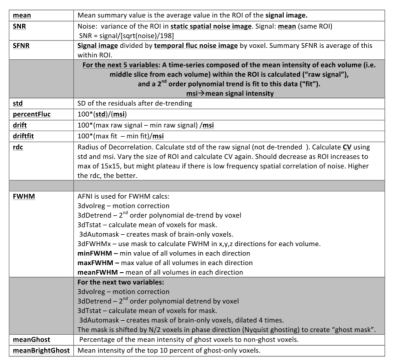 |
22 |
 Inter-site MRI scanner resolution and stability variance revealed by EPI fMRI phantom scans: a multi-site Canadian study Inter-site MRI scanner resolution and stability variance revealed by EPI fMRI phantom scans: a multi-site Canadian study
M. Aras Kayvanrad, Aditi Chemparathy, Stephen Arnott, Fan Dong, Mojdeh Zamyadi, Tom Gee, Robert Bartha, Christopher Scott, Sandra Black, Sean Symons, Glenda MacQueen, Jacqueline Harris, Andrew Davis, Geoffrey Hall, Stefanie Hassel, Stephen Strother
The Ontario Neurodegenerative Disease Research Initiative (ONDRI) and the Canadian Biomarker Integration Network in Depression (CAN-BIND) are multisite longitudinal studies that employ 12 MRI scanners across Canada (6 in CAN-BIND) to collect neuroimaging data. To ensure comparability of neuroimaging data collected at different sites, fBIRN (functional Biomedical Informatics Research Network) phantoms have been scanned approximately monthly at each site for more than two years to obtain quality assurance (QA) measures from the fBIRN pipeline. In this abstract we present our investigations into within- and between-site variations due primarily to differences in full-width-at-half-maximum (FWHM) measures of imaging resolution.
|
|
5460.
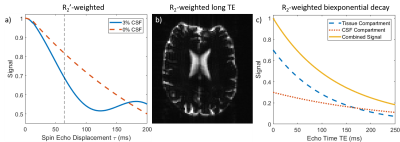 |
23 |
 Correcting for the influence of cerebrospinal fluid in quantification of R2’ and deoxygenated blood volume (DBV) using quantitative BOLD Correcting for the influence of cerebrospinal fluid in quantification of R2’ and deoxygenated blood volume (DBV) using quantitative BOLD
Matthew Cherukara, Alan Stone, Michael Chappell, Nicholas Blockley
Streamlined qBOLD (sqBOLD) can be used to quantify deoxygenated blood volume and the reversible relaxation rate R2’ (used to estimate oxygen extraction fraction), although it is vulnerable to systematic errors from a number of confounding factors including the presence of cerebrospinal fluid (CSF). A FLAIR inversion preparation is typically used to null the CSF signal, but this results in a reduction in SNR, and increases scan time. We present a post-processing method to account for the presence of CSF that has the potential to improve both the accuracy and efficiency of the sqBOLD technique without the need for FLAIR preparation.
|
|
5461.
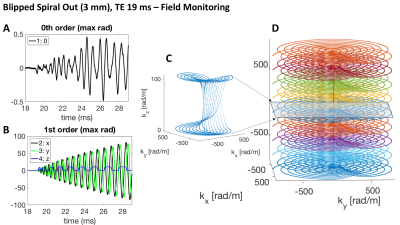 |
24 |
 Rapid 3D Blipped Spiral fMRI at 7 T Rapid 3D Blipped Spiral fMRI at 7 T
Lars Kasper, Maria Engel, Christoph Barmet, Jonas Reber, Jakob Heinzle, Klaas Stephan, Klaas Pruessmann
We present 3D blipped spiral fmri at 7T with a fast TR of 0.54s. Compared to 2D spirals, the 3D nature allows parallel imaging in z direction and blipped sampling of multiple planes that accelerate acquisition time, while the inherent averaging of multiple shots retains sufficient SNR. Intershot field inconsistency due to breathing and trajectory changes due to gradient heating in this high duty cycle sequence are compensated by NMR probe-based concurrent field monitoring, recovering high image quality and tSNR. We show the feasibility for fmri with 3D blipped spirals in a visual paradigm.
|
|
Analysis Methods: Task-Based fMRI
Electronic Poster
fMRI
Thursday, 21 June 2018
| Exhibition Hall |
13:15 - 14:15 |
| |
|
Computer # |
|
5462.
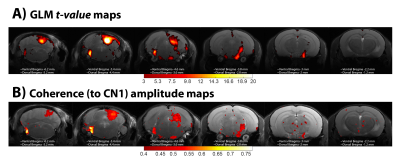 |
25 |
 Mouse auditory pathway mapping using BOLD fMRI coherence analysis Mouse auditory pathway mapping using BOLD fMRI coherence analysis
Cristina Chavarrias, Guilherme Blazquez Freches, Noam Shemesh
The feasibility and potential of mapping the mouse auditory system through functional magnetic resonance imaging (fMRI) in mice was recently demonstrated. The goal of this work was to compare the conventional GLM analysis, which relies on the variability across regions of the haemodynamic response, with a coherence analysis, which is data-driven and provides rich temporal information. Coherence amplitudes closely follow the pattern of the GLM maps, whereas the delay maps obtained from the coherence phase show different latencies even inside each ROI. This suggests the utility of coherence analysis for mapping the auditory pathway in-vivo.
|
|
5463.
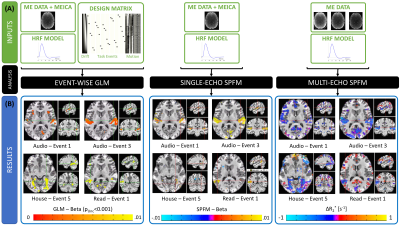 |
26 |
 Improved detection of neuronal-related BOLD events of unknown timing with Multi-Echo Sparse Paradigm Free Mapping Improved detection of neuronal-related BOLD events of unknown timing with Multi-Echo Sparse Paradigm Free Mapping
Cesar Caballero-Gaudes, Javier Gonzalez-Castillo, Peter Bandettini
This work introduces an extension of sparse paradigm free mapping (SPFM) for multiecho (ME) fMRI: ME-SPFM. Based on the ME-fMRI signal model and L1-norm regularized estimators, ME-SPFM produces voxel-wise estimates of time-varying changes in the transverse relaxation ($$$R_2^*$$$) and the net magnetization ($$$S_0$$$) without prior information about experimental paradigms. Our evaluations demonstrate that ME-SPFM significantly outperforms its SE counterpart in terms of sensitivity and specificity, nearly matching that of traditional model-based analyses. ME-SPFM’s ability to blindly detect individual events at the single-subject level makes it an ideal candidate to explore the time-varying nature of brain activity in experimentally unconstrained paradigms (naturalistic, resting-state) or clinical applications (detection of inter-ictal epileptic events).
|
|
5464.
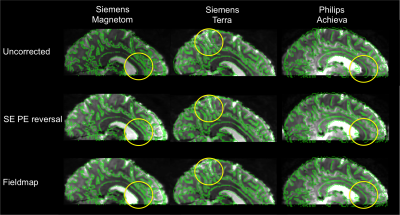 |
27 |
 A comparison of distortion correction methods for EPI fMRI applied across three 7T platforms A comparison of distortion correction methods for EPI fMRI applied across three 7T platforms
Ian Driver, Olivier Mougin, William Clarke, Catarina Rua, Adrian Carpenter, Keith Muir, Stuart Clare, Susan Francis, Richard Wise, Richard Bowtell
In preparation for a wider multi-site ‘travelling heads’ 7T fMRI study, we compare the performance of EPI distortion correction techniques for fMRI data across four sites, using three different 7T platforms. Specifically, we compare B0-map and phase-encoding reversal methods, applied to both task and resting state fMRI data.
|
|
5465.
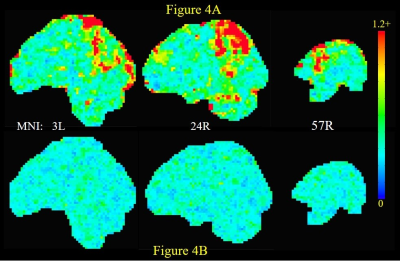 |
28 |
 Serial Correlations in fMRI Time-Series Arise from Non-Stochastic Signals Related to Brain Function Serial Correlations in fMRI Time-Series Arise from Non-Stochastic Signals Related to Brain Function
Kaundinya Gopinath, Venkatagiri Krishnamurthy, K Sathian
In this study, we first demonstrate using resting state fMRI (rsfMRI) “null” datasets, that serial correlation in fMRI time-series arises from non-stochastic signals (e.g., coordinated activity within brain function networks unrelated to the fMRI paradigm of interest). Using this principle, we then advance a method to obtain whitened GLM first-level analysis regression residuals in task fMRI studies, by accounting for non-stochastic brain signals through principal components analysis. Importantly, the proposed methods is insensitive to the temporal resolution of fMRI time-series, unlike conventional stochastic models of serial correlation, whose parameters have to be modified depending on fMRI scan-TR.
|
|
5466.
 |
29 |
 Predicting Individual Task Performance From Resting State fMRI: Effects of Training Task Data Quality Predicting Individual Task Performance From Resting State fMRI: Effects of Training Task Data Quality
Alexander Cohen, Elizabeth Zakszewski, Yang Wang
Resting state functional MRI (rs-fMRI) has been used to predict individual task activation by training a model to map rs-fMRI networks to task performance. This study used a multiband, multi-echo acquisition to collect motor task fMRI as training data. The effects of echo combination and denoising of the training-task data on rs-fMRI predictions were examined. Multi-echo task data resulted in increased predictive accuracy of the model. These results suggest the quality of the training-task data affects the accuracy of the prediction model.
|
|
5467.
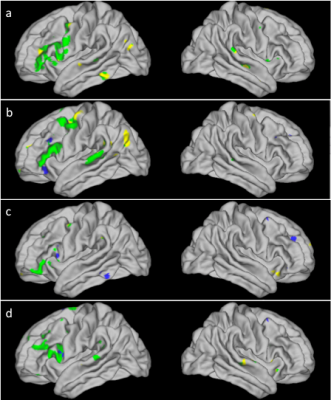 |
30 |
 Predicting individual language task activation from resting state fMRI using a novel data-driven approach Predicting individual language task activation from resting state fMRI using a novel data-driven approach
Elizabeth Zakszewski, Alexander Cohen, Oiwi Parker Jones, Saad Jbabdi, Yang Wang
This study is aimed to apply a newly developed machine learning approach to predict individual language network based on the resting state functional MRI (rs-fMRI). Despite the presence of significant variability of language network across subjects, the predicated language maps match excellently with the language task fMRI derived activation maps at the individual level. Our results suggest that rs-fMRI can be used as a promising clinical tool for mapping language network by using the novel processing approach.
|
|
5468.
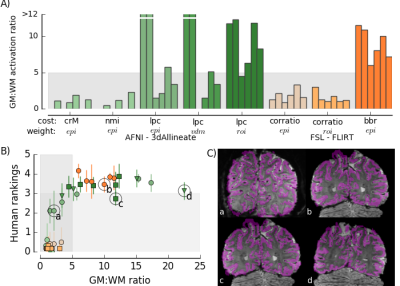 |
31 |
 An automated method for assessing the accuracy of cross-modal registration in high-field fMRI An automated method for assessing the accuracy of cross-modal registration in high-field fMRI
Cheryl Olman, Kimberly Weldon, Andrea Grant, Philip Burton, Essa Yacoub
In this work, we developed a method for evaluating the quality of cross-modal registration of functional and anatomical MRI datasets that obviates the need for subjective human judgments. In brief, we propose that the overlap of an activation mask derived from the functional data with a binary GM mask derived from the reference anatomical volume is a useful metric for overall registration quality. In addition, we promote the use of activation consistency throughout the gray matter as an inclusion criterion for regions of interest when computing laminar (depth-dependent) profiles, provided that the activation is computed in a robust, independent localizer.
|
|
5469.
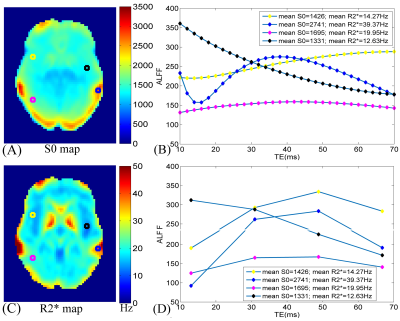 |
32 |
 A comparison between amplitude of low frequency fluctuation calculation methods based on R2* signal and traditional T2*-weighted signal A comparison between amplitude of low frequency fluctuation calculation methods based on R2* signal and traditional T2*-weighted signal
Li-Xia Yuan, Li-Sha Yuan, Hong-Jian He, Jian-Hui Zhong, Yu-Feng Zang
The amplitude of low frequency fluctuation (ALFF) is usually computed from T2*-weighted functional MRI (fMRI) signals, which is affected by R2* fluctuation, echo time, spin density, and mean R2*. To make ALFF more comparable and reliable between researches, we proposed a new method of ALFF calculation based on R2* (ALFF-R2*) in this work and further implemented for multi-echo fMRI. Statistical results from eyes-open and eyes-closed fMRI datasets show that ALFF-R2* detected an overall smaller significant regions than traditional ALFF in the paired T maps. The dice similarity coefficient between T maps from ALFF-R2* and traditional ALFF was 0.37. ALFF-R2* is potential to provide more specific results than traditional ALFF.
|
|
5470.
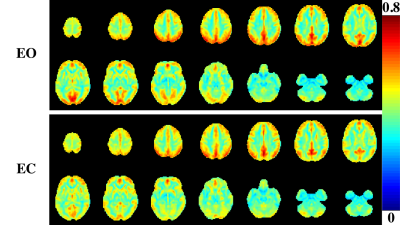 |
33 |
Comparison of the functional correlation tensor under eyes closed and eyes open conditions
Did Not Present
Yang Fan, Jing Wang, Bing Wu
Recently, a novel technique was proposed directly integrated resting-state fMRI and DTI techniques to construct a local spatio-temporal correlation tensor from resting state fMRI data, termed as the functional correlation tensor. Previous studies demonstrated that resting-state fMRI properties varied from different resting conditions, such as eyes closed, eyes open and fixation. However, whether the functional correlation tensor will be affected by different baseline conditions is still need to be investigated. In this study, group-level properties of the functional correlation tensor were assessed and compared under eyes closed and eyes open conditions.
|
|
5471.
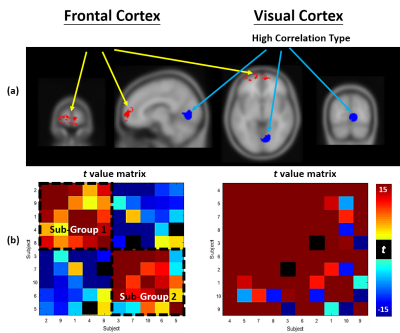 |
34 |
 Using Hierarchical Clustering Method to Reveal the Formation of Sub-groups among Subjects at Frontal Cortex in fMRI study with Complex Natural Stimulus Using Hierarchical Clustering Method to Reveal the Formation of Sub-groups among Subjects at Frontal Cortex in fMRI study with Complex Natural Stimulus
Jacky, Tai-Yu Lu, Yi-Tien Li, Yi-Cheng Hsu, Fa-Hsuan Lin
The inter-subject correlation (ISC) analysis which is widely used in functional magnetic resonance imaging (fMRI) studies with complex natural stimulus design. It has been reported that relatively lower ISC value at higher cognitive brain areas could be inferred for individual variability. This study proposed the hierarchical clustering analysis method to discover the formation of sub-groups which showed positive correlation within the sub-group members but negative or non-correlation between the sub-groups among subjects. We found that the existence of sub-groups among whole subjects rather than non-correlation at frontal cortex. The synchronized brain activity could be found at frontal cortex within each sub-group.
|
|
5472.
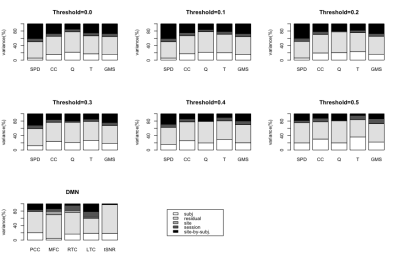 |
35 |
 Multi-site reliability of Default Mode Network and Graph Theoretical Measures in Resting State fMRI Multi-site reliability of Default Mode Network and Graph Theoretical Measures in Resting State fMRI
Sumra Bari, Pratik Kashyap, Kausar Abbas, Brenna McDonald, Thomas Talavage
This study investigated the multi-site reliability of resting state fMRI (rs-fMRI) using Default Mode Network (DMN) connectivity and graph theory measures like mean shortest path distance, clustering coefficient, modularity, transitivity and global mean strength. Test-retest and between-site reliability for all metrics were calculated by variance component analysis using restricted maximum likelihood (REML) estimates. Test-retest reliability was found to be poor to fair and between-site reliability was consistently poor for all metrics.
|
|
5473.
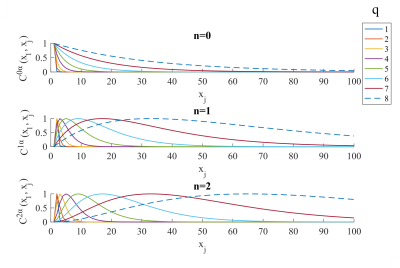 |
36 |
 Accurate modelling of temporal correlations in rapidly sampled fMRI time series using “FAST”. Accurate modelling of temporal correlations in rapidly sampled fMRI time series using “FAST”.
Nadège Corbin, Nick Todd, Karl Friston, Martina Callaghan
Accurate estimation of the temporal correlations that exist in fMRI time-series is essential in order to avoid a high false positive rate. A common approach is to pre-whiten data using an AR(1)+white noise model. However, this approach proves insufficient for repetition times (TR) <1.5s. An alternative is to expand the set of covariance components included in the model (of serial correlations), as in the “FAST” option implemented by SPM12. Here, we show that this model can be used to accurately pre-whiten rapidly sampled data, and identify an upper bound on the parameterisation (i.e., number of covariance components) that precludes numerical overflow with ill-conditioned matrices. Such a model is important given the increasing use of rapid imaging techniques, such as multiband imaging. Using this technique, 18 components provided robust results with TR times ranging from 0.35s to 2.8s.
|
|
5474.
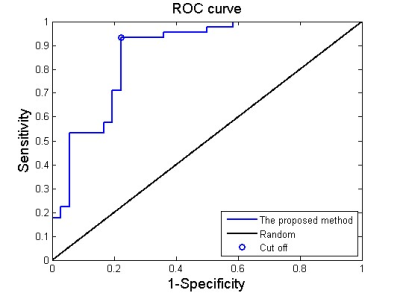 |
37 |
A support vector machine-based method to identify non-neuropsychiatric systemic lupus erythematosus with Regional Homogeneity
Did Not Present
Xiangliang Tan, Zhuqing Long, Yingjie Mei, Wenjun Qiao, Kai Han, Yikai Xu
Previous studies found that changes in brain function happened in default mode network beforeNeuropsychiatric involvement (NPSLE) development by using resting-state functional magnetic resonance imaging (rs-fMRI), highlighting the need for early evaluation and intervention in SLE patients. In this study, we proposed a valid Support Vector Machine (SVM) -based method to identify non-NPSLE using regional homogeneity (ReHo). The results demonstrate that ReHo parameter is an effective classification feature for the SVM-based method to identify SLE patients from healthy subjects.
|
|
5475.
 |
38 |
 Temporal autocorrelation bias still exists in fMRI results Temporal autocorrelation bias still exists in fMRI results
Wiktor Olszowy, John Aston, Catarina Rua, Guy Williams
Given the recent trend towards validating the neuroimaging methods, we compared the most popular fMRI analysis softwares: AFNI, FSL and SPM, with regard to autocorrelation modelling. We used both resting-state and task-based fMRI data, for which we assumed different experimental designs. For FSL and SPM we observed a strong relationship that the lower the assumed experimental design frequency, the more likely it was to observe significant activation. It indicates that pre-whitening in FSL and SPM does not remove a substantial part of the temporal autocorrelation in the noise. Our study points to superior autocorrelation modelling in AFNI.
|
|
5476.
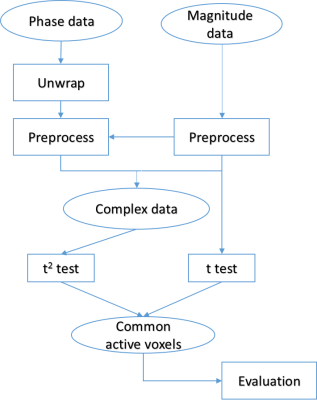 |
39 |
 Complex-valued analysis of high-resolution SSFP-fMRI increases reliability in detecting active voxels Complex-valued analysis of high-resolution SSFP-fMRI increases reliability in detecting active voxels
Vahid Malekian, Arash Foroudi Ghasemabadi, Abbas Moghaddam
In this study, we evaluated the reliability of the results of a complex-valued analysis that uses both magnitude and phase data in a SSFP-fMRI technique. From the activation map of complex analysis and the corresponding magnitude one, we selected the common active voxels and calculated the average z-score over all of them. By observing an approximately 9.4% increase of z-score in complex maps compared to magnitude ones, we can conclude that by using both magnitude and phase data we are able to increase the confidence and reliability of detecting active voxels. Therefore, complex analysis method can be promising in evaluating SSFP-fMRI methods.
|
|
5477.
 |
40 |
 High Resolution fMRI Data De-noising Technique Using Spatio-Temporal Diffusion Filter High Resolution fMRI Data De-noising Technique Using Spatio-Temporal Diffusion Filter
Vahid Malekian, Abbas Moghaddam
Diffusion-based filtering approaches are widely used in MR image de-noising literature but only a few studies, utilize this technique for fMRI applications. In these studies, 1D & 2D diffusion filters were applied using temporal and spatial information separately. Here, a novel spatio-temporal diffusion filtering method is proposed for high-spatial resolution fMRI data which has sufficient contrast between gray matter and other tissues. The results on the experimental SSFP data shows the ability of the proposed technique in improving functional sensitivity as well as preserving the edges of active regions in high-resolution fMRI techniques.
|
|
5478.
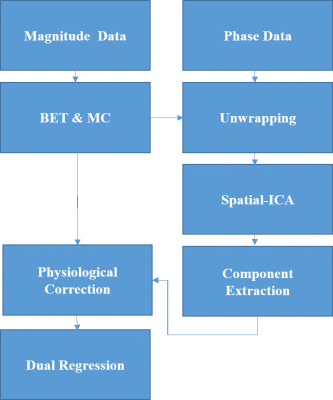 |
41 |
 A novel phase-based technique to reduce physiological noise in resting state fMRI data A novel phase-based technique to reduce physiological noise in resting state fMRI data
Vahid Malekian, Abbas Moghaddam, Daniel Gomez, Jose Marques, David Norris
In this study, a novel phase-based technique is proposed to decrease the effects of physiological noise in resting-state fMRI data. Our technique is based on extracting nuisance components from the phase of fMRI data using spatial-ICA and utilize it to clean magnitude data. To evaluate, we performed the proposed method on Multi-Band fMRI data which benefits from higher temporal resolution to encode physiological effects and compare the efficacy of the technique both with magnitude-based and with RETRIOCOR techniques. Our method has marginal higher identifiability index and z-score’smean values compared to magnitude-based and RETROICOR methods.
|
|
5479.
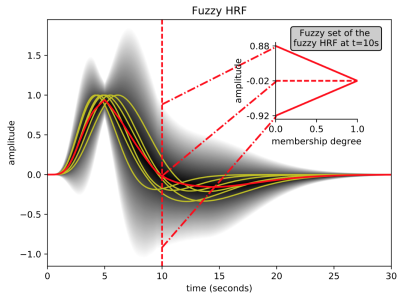 |
42 |
 Fuzzy GLM approaches based on LR and alpha-cut representations for fMRI activity detection Fuzzy GLM approaches based on LR and alpha-cut representations for fMRI activity detection
Alejandro Veloz, Steren Chabert, Alejandro Weinstein, Hector Allende, Claudio Moraga
The General Linear Model (GLM) approach is still the standard paradigm used in routine fMRI analysis. This method is based on a model of the BOLD response which depends on the Hemodynamic Response Function (HRF). The HRF ignores the intrinsic intra- and inter-subject variability, resulting in inaccuracies in the brain activity detection. This work leverages on fuzzy sets theory with the purpose of developing a fuzzy GLM to overcome limitations of current GLM-based approaches. We performed an evaluation on simulated and in vivo fMRI data. We compare our results with aproaches based on dictionary learning and wavelet decomposition.
|
|
5480.
 |
43 |
 Smooth global fMRI signals facilitate robust cross-subject classification of naturalistic movie stimuli Smooth global fMRI signals facilitate robust cross-subject classification of naturalistic movie stimuli
Hendrik Mandelkow, Jacco de Zwart, Jeff Duyn
The imprecision of anatomical alignment methods commonly limits the spatial resolution and sensitivity of conventional fMRI analysis based on statistical parametric mapping. Recently proposed machine-learning methods aim to circumvent the cross-subject (XS) alignment problem by computing a linear projection of the fMRI signal from each subject's anatomical space to a common albeit abstract "functional" space [1][2]. The success of these "hyperalignment" methods is often attributed to a spatially and functionally specific (linear) correspondence between the fMRI signal in different subjects under similar stimulation conditions. Cross-subject PCA of averaged fMRI data from repeated movie-viewing experiments reveals smooth globally distributed fMRI signal components that facilitate robust cross-subject classification by Linear Discriminant Analysis (LDA). Such global cortical network activity may contribute to the success of fMRI hyperalignment strategies.
|
|
5481.
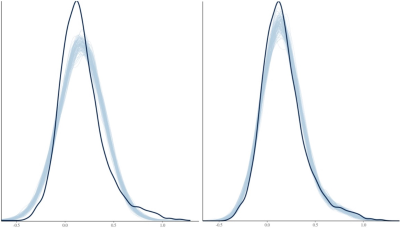 |
44 |
 Can Sensitivity and Specificity Be Gained Simultaneously in Neuroimaging? Can Sensitivity and Specificity Be Gained Simultaneously in Neuroimaging?
Gang Chen, Yaqiong Xiao, Paul Taylor, Fengji Geng, Tracy Riggins, Elizabeth Redcay, Robert Cox
Whole brain analysis currently faces two challenges: the increasing demand of correction for multiplicity and the usual tug of war between specificity and sensitivity. In addition, sensitivity suffers substantially because of stringent correction, while specificity is not directly considered when forming clusters. Specificity can be largely guaranteed through ROI-based analysis if ROIs can be a priori defined. Furthermore, sharing information across ROIs through an integrated model can improve model efficiency and detection power. We offer an alternative or complementary approach to the conventional methods in resolving the dilemma of multiple comparisons and dichotomous decisions. Lastly, through the approach, we promote totality and transparency in results reporting, and avoid the hard thresholding of a p-value funnel.
|
|
5482.
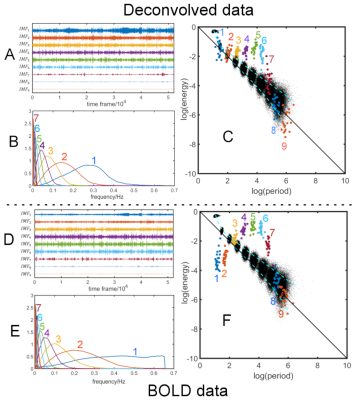 |
45 |
 Frequency Characteristics of Blind-Deconvolved Resting-State Networks using Empirical Mode Decomposition Frequency Characteristics of Blind-Deconvolved Resting-State Networks using Empirical Mode Decomposition
Dietmar Cordes, Muhammad Kaleem, Xiaowei Zhuang, Karthik Sreenivasan, Zhengshi Yang, Tim Curran, Virendra Mishra
Energy-period relationships and frequency content of Intrinsic Mode Functions (IMFs) were studied in deconvolved fMRI data using a blind deconvolution method. Results are shown for multiband MB8 resting-state data collected with a TR of 0.765s for a group of 22 healthy subjects. Findings of the present study suggest that high-frequency content in the major primary resting-state networks (such as the Default Mode Network, Visual Network, Auditory Network, or Fronto-Parietal network) is rather limited and not supported to be of any significance for high frequencies larger than 0.21 Hz, whether in BOLD data or blind-deconvolved data.
|
|
5483.
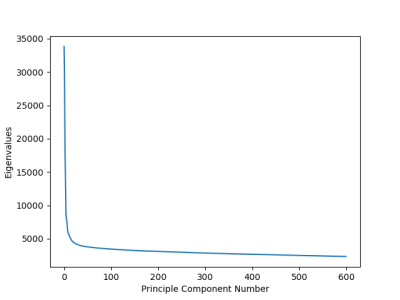 |
46 |
PCA Based Noise Reduction of Delay Maps Obtained from Human Connectome Project Resting State fMRI Data
Video Permission Withheld
Serdar Aslan, Blaise Frederick
Previous work from our group has presented compelling evidence that systemic low frequency oscillations (sLFOs), the major constituent of low frequency global systemic noise overlying resting state functional networks, propagate dynamically throughout the brain with cerebral blood circulation. More specifically, it has been demonstrated that sLFOs travel with the bulk cerebral blood flow with voxel-specific arrival time delays, and their spatiotemporal pattern changes in a way that tracks cerebral blood flow dynamics. We are interested in using the Human Connectome Project (HCP) dataset to determine normative blood flow delays throughout the brain. Time delay maps were obtained by the Regressor Interpolation at Progressive Time Delays (RIPTiDe) method , which was applied to 487 subjects of the HCP 500 subjects release data. While the procedure generates extremely clean mean delay maps, the individual delay maps are quite noisy. Because the circulation delays should in general be slowly varying in space, PCA noise reduction is a natural choice to preserve the spatial structure of the delay maps while removing random noise points.
|
|
5484.
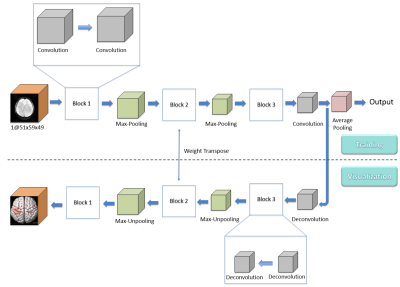 |
47 |
 Multivariate Pattern Analysis of fMRI Data using Deep Neural Network Multivariate Pattern Analysis of fMRI Data using Deep Neural Network
Yi-Cheng Wang, Jia-Ren Chang, Chia-Lin Chen, Ching-Ju Yang, Wei-Chi Li, Jen-Chuen Hsieh, Li-Fen Chen, Yong-Sheng Chen
This paper presents a novel MVPA method based on deep neural networks, which can identify a group of voxels with their pattern of activity capable of differentiating experimental conditions. Through the forward inference procedure, the proposed deep neural network can also be applied to distinguish brain imaging data of different experimental conditions. Our experimental results suggest that deep neural networks are of great potential as an MVPA tool for functional brain mapping.
|
|
5485.
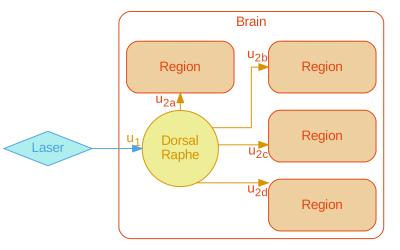 |
48 |
 Serotonergic Excitability and Functional Connectivity in Acute, Chronic, and Withdrawal Phases of Antidepressant Treatment Serotonergic Excitability and Functional Connectivity in Acute, Chronic, and Withdrawal Phases of Antidepressant Treatment
Horea-Ioan Ioanas, Bechara Saab, Markus Rudin
The serotonergic system is characterized by high centrality and is implicated in affective disorders and their treatment. During longitudinal antidepressant (fluoxetine) administration in mice, we optogenetically stimulate the ascending serotonergic system, and infer brain activity via fMRI. We resolve serotonergic excitability and functional connectivity at 5 time points and show that a network representation is needed to adequately model the data. For acute and chronic sessions we document significantly increased serotonergic excitability, and distinctly multivariate effects on serotonergic transmission. Finally, we find a full brain function recovery to baseline after fluoxetine withdrawal.
|
|
fMRI: Connectivity Methods
Electronic Poster
fMRI
Thursday, 21 June 2018
| Exhibition Hall |
14:15 - 15:15 |
| |
|
Computer # |
|
5534.
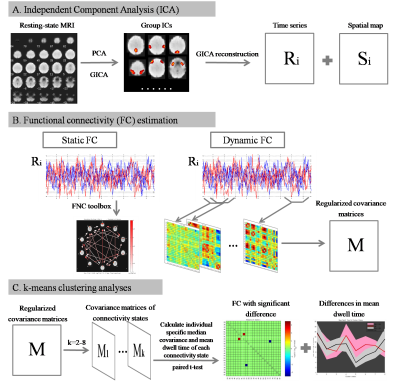 |
1 |
 How people recover from extreme life stress: a longitudinal dynamic functional connectivity analysis How people recover from extreme life stress: a longitudinal dynamic functional connectivity analysis
Jing Jiang, Kaiming Li, Xiaoqi Huang, Su Lui, Zhiyun Jia, Qiang Yue, Qiyong Gong, Qiyu Liu
Dynamic functional connectivity (dFC) has provided more information than commonly-used static FC analysis. With dFC, we investigated the variation characteristics of three affected resting state networks, i.e., DMN, CEN and SN, in trauma-exposed non-PTSD group using resting state fMRI scans within 25 days and 2 years after Wenchuan earthquake. Results revealed increased connectivity was mainly involved in intra-network FC of DMN and inter-network FC between SN and DMN/CEN. Decreased connectivity was mostly found in intra-network FC of CEN and inter-network FC between CEN and SN. This study may provide insights of how people recover from extreme life stress from a FC variation perspective.
|
|
5535.
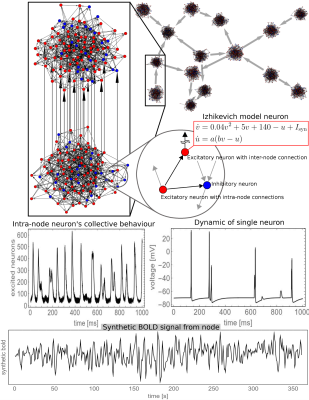 |
2 |
From neurons to BOLD connectivity: a validation study
Video Permission Withheld
Andrea Duggento, Luca Passamonti, Gaetano Valenza, Riccardo Barbieri, Maria Guerrisi, Nicola Toschi
The use of Multivariate Granger Causality (MVGC) in estimating directed BOLD connectivity is still controversial. We employ realistic complex network models based on Izhikevich neuronal populations interlinked by realistic neuronal fiber bundles which exert compounded directed influences and cascade into Baloon-model-like neurovascular coupling. We show in silico that the top 1 percentile of a BOLD connectivity matrix has a Positive Predictive Value very close to 1, and demonstrate in HCP data that functional interactions between parietal and prefrontal cortices are not symmetrical, but consists of directional connectivity from parietal areas to prefrontal cortices rather than vice versa.
|
|
5536.
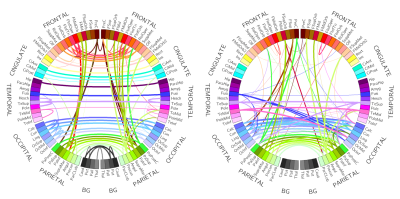 |
3 |
In-variance causality: a novel layer of information in directed connectivity
Video Permission Withheld
Andrea Duggento, Luca Passamonti, Maria Guerrisi, Nicola Toschi
Multivariate Granger Causality (MVGC) approaches have recently been employed to estimate the directionality of brain connectivity. While BOLD fluctuations also contain information about neurovascular coupling, so far all MVGC estimation frameworks have focused on central tendencies, hence disregarding directed coupling between volatilities (i.e. in-variance causality). In this paper, we develop a framework for simultaneous estimation of both in-mean and in-variance causality in complex networks. We validate our approach using synthetic data from complex ensembles of coupled nonlinear oscillators, and successively employ HCP data to provide the very first estimate of the in-variance connectome of the human brain.
|
|
5537.
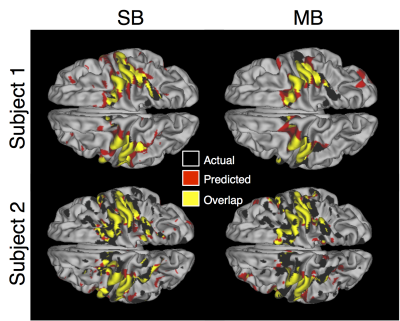 |
4 |
 Predicting Task Activation from Resting State fMRI: A Comparison of Single Band and Multiband EPI Acquisitions Predicting Task Activation from Resting State fMRI: A Comparison of Single Band and Multiband EPI Acquisitions
Alexander Cohen, Elizabeth Zakszewski, Yang Wang
Recent studies have used resting state functional MRI (rs-fMRI) to predict task activation on an individual basis using a linear-regression machine learning technique. Limited existing studies have used either low-resolution single-band (SB) or high-resolution multiband (MB) data and shown promising results. In this study, SB and MB resting state data were acquired in a group of volunteers to compare their ability to predict motor task activation. Our results showed no significant differences between SB- and MB-based motor task predictions. These findings suggest conventional SB scans might be suitable for making predictions regarding task activation in some clinical settings.
|
|
5538.
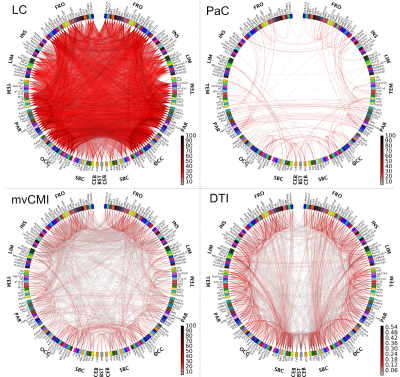 |
5 |
 Individual Resting-State Brain Networks using Multivariate Conditional Mutual Information Individual Resting-State Brain Networks using Multivariate Conditional Mutual Information
Padmavathi Sundaram, Martin Luessi, Marta Bianciardi, Steven Stufflebeam, Matti Hamalainen, Victor Solo
Current methods of functional brain connectivity from resting-state fMRI data such as linear correlation have limitations, which result in connectivity maps affected by indirect connections and information loss. To address these problems, we propose to use a multivariate conditional mutual information (mvCMI) measure. mvCMI is a multivariate association method, which does not discard information and eliminates indirect connections. We tested mvCMI for single-subject fMRI-connectivity analysis in 10 healthy subjects. mvCMI was able to generate single-subject maps of functional connectivity showing mostly direct connections; mvCMI-based connectivity-maps were more closely related to diffusion-tensor-imaging-based structural connectivity-maps than linear-correlation-based connectivity-maps.
|
|
5539.
 |
6 |
 Mapping the functional recovery of brainstem injury-induced comatose rats with eigenvector-centrality mapping and seed-based analysis of resting-state fMRI Mapping the functional recovery of brainstem injury-induced comatose rats with eigenvector-centrality mapping and seed-based analysis of resting-state fMRI
Patricia Pais Roldán, Brian Edlow, Johannes Stelzer, Yuanyuan Jiang, Ming Zou, Xin Yu
Here we used the rat brainstem coma model and rs-fMRI to systematically study the network dynamics during recovery from coma. Using whole brain connectivity analysis we obtained connectivity slope maps from the comatose animals, which revealed the brain regions with higher connectivity changes. In parallel, we performed a seed-based analysis to specify the strengthened connections between ROIs. Both methods indicated an increase in the connectivity between basal forebrain, basal ganglia and thalamus, along the acute phase of recovery from coma. These parallel analyses applied to comatose rats provided new insights into the regulations occurring during recovery of consciousness.
|
|
5540.
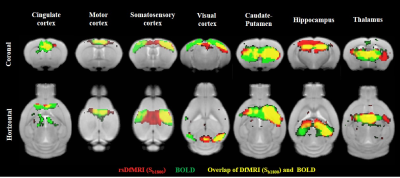 |
7 |
 A correlation of resting state DfMRI signals reflects functional connectivity in awake mouse A correlation of resting state DfMRI signals reflects functional connectivity in awake mouse
Yoshifumi Abe, Yuki Sakai, Hiroaki Hamada, Norio Takata, Kenji Doya, Kenji Tanaka
Diffusion fMRI (DfMRI) is an imaging method to investigate brain activity regardless of hemodynamic state. The previous study has proposed that resting state DfMRI (rsDfMRI) is suitable to investigate a magnitude of basal activity. In this study, we examined our hypothesis that this rsDfMRI have a potential of detecting functional connectivity (FC). FC patterns were compared between rsDfMRI and BOLD-rsfMRI in awake mice. A strong correlation of the pattern between rsDfMRI and BOLD-rsfMRI indicated that rsDfMRI is possible to conduct FC analysis. Therefore, we propose that rsDfMRI is a powerful tool to detect brain network as well as brain activity.
|
|
5541.
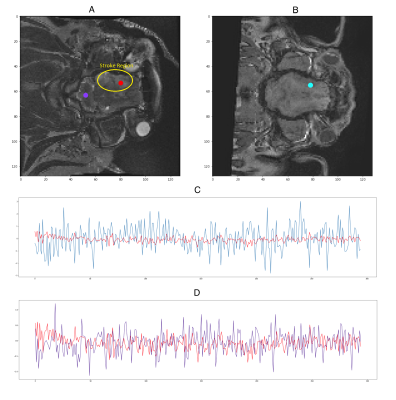 |
8 |
 A New Method of Brain Functional Connectivity Analysis via Deep Learning A New Method of Brain Functional Connectivity Analysis via Deep Learning
Brandon Campbell, Alice Shen, Simon Platt, Franklin West, Qun Zhao
The pig brain model is an important translational model due to its similarity to the human brain anatomy and physiology. However, a lack of a priori information required for common functional analysis techniques dictates that new techniques are required to explore the connectivity of the pig brain. Here we present two new, unsupervised forms of analysis to find functional connectivity in healthy and ischemic stroke pigs using sparse deep convolutional neural networks and dynamic time warping with spectral clustering that yield complementary results.
|
|
5542.
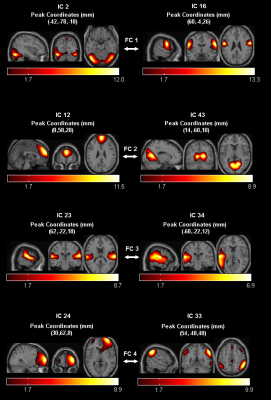 |
9 |
 Functional Connectivity-Based Classification of Gulf War Illness Patients vs Control Veterans Functional Connectivity-Based Classification of Gulf War Illness Patients vs Control Veterans
Unal "Zak" Sakoglu, Mounika Galla, Bruce Crosson, Robert Haley, Kaundinya Gopinath
Around 200,000 veterans suffer from Gulf War Illness (GWI). GWI is characterized by multiple deficits in cognitive, emotion, somatosensory and pain domains. In this study we studied 23 GWI patients and 30 age-matched controls with resting state fMRI in order to classify patients versus controls using functional connectivity among brain networks. Results show that different brain networks have discriminating power, signaling widespread impairments in functional connectivity of visual, semantic, multi-sensory, and sensory-motor processing networks in GWI consistent with multi-symptom nature of the illness.
|
|
5543.
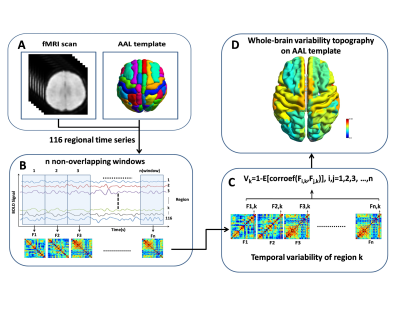 |
10 |
Dynamic network analysis reveals altered temporal variability in brain regions after brain stroke: A longitudinal resting-state fMRI study
Did Not Present
Jianping Hu, Juan Du, Qiang Xu, Fang Yang, Fanyong Zeng, Zhiqiang Zhang, Guangming Lu
In this work, we seek to investigate the longitudinal alteration of temporal variability in
resting-state brain network after cerebral stroke, by using a novel dynamic network analysis. Our study
illustrated a time dependent alteration of temporal variability in brain networks following stroke
recovery. These findings expand our understanding for dynamic properties of brain networks and
provide new insight into the underlying mechanisms of reorganization and integration of functional
networks over the recovery process after stroke.
|
|
5544.
 |
11 |
 Combining regional homogeneity and Meta-analysis to improve preoperative language mapping with resting-state functional MRI Combining regional homogeneity and Meta-analysis to improve preoperative language mapping with resting-state functional MRI
Ai-Ling Hsu, Jason Johnson, Kyle Noll, Sujit Prabhu, Donald Schomer, Jyh-Horng Chen, Ho-Ling Liu
Resting-state (rs) fMRI has been shown its potential for pre-surgical mapping. Seed-correlation analysis is a commonly used approach for network detection. However, lesion-related spatial distortions and functional reorganization make the seed selection difficult for rs-fMRI mapping based on anatomical landmark alone. Here we proposed a novel approach to guide the seed selection for rs-fMRI mapping in patients with brain tumors by incorporating regional homogeneity (RH) confined by results of meta-analysis (MA). Our results showed performance that was equivalent to the seed localization guided by task-fMRI activation, suggesting the potential of RH+MA approach for rs-fMRI mapping in the clinical practice.
|
|
5545.
 |
12 |
Altered Variability in Functional Connectivity of the Anterior Cingulate Cortex in Patients with Treatment-resistant and Non-treatment-resistant Depression
Did Not Present
Bochao Cheng, Gang Ning, Qiyong Gong
Although substantial efforts have been made to elucidate the neuronal basis of both Treatment-resistant depression (TRD) and non-TRD (nTRD), the results are inconsistant. We apply the resting-state dynamic functional connectivity (D-RSFC) to explore the divergence of neuronal basis of both depression subtypes. Our results demonstrated that the prefrontal-limbic circuit is the most stable dysfunctional brain network in depression. The D-RSFC method could reveal the altered dynamic functional connectivity in both MDD subtypes and the divergence of brain networks between TRD and nTRD. Additionally, we speculate that the caudate-ACC circuit might be the biomarker for evaluating treatment response in TRD.
|
|
5546.
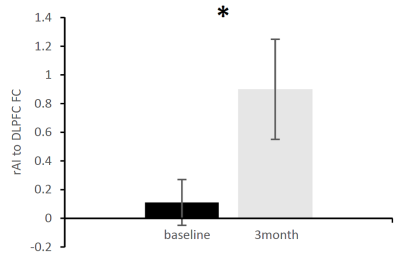 |
13 |
 Baseline dynamic functional connectivity predicts response to repetitive transcranial magnetic stimulation in patients with treatment-resistant depression Baseline dynamic functional connectivity predicts response to repetitive transcranial magnetic stimulation in patients with treatment-resistant depression
Sarina Iwabuchi, Dorothee Auer, Sudheer Lankappa, Lena Palaniyappan
Repetitive transcranial magnetic stimulation (rTMS) is becoming increasingly popular for the treatment of depression. However, there is a need for improving response through identifying predictive biomarkers and understanding mechanisms underlying treatment response to enable stratified patient care. We investigated in a group of 27 patients with treatment resistant depression, whether dynamic interactions between brain networks (measured with resting-state fMRI) can predict clinical response following 4 weeks of rTMS treatment. We found that clinical response may be more related to ‘trait’ like dynamic balance among large-scale networks that are present at the outset of treatment.
|
|
5547.
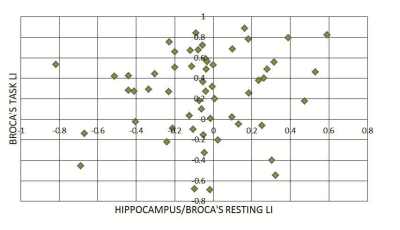 |
14 |
 Resting Functional Connectivity Across a Language Network Not Related to Task Based Language Laterality Index Resting Functional Connectivity Across a Language Network Not Related to Task Based Language Laterality Index
Akhila Ashokan, Victoria Morgan
Quantification of language dominance via a laterality index is used to assess the risk of language impairment prior to temporal lobe resection, most commonly in temporal lobe epilepsy. While task based functional MRI has become a useful non-invasive method for this measure, its reliability and accuracy can be reduced by poor task performance. In this work, resting fMRI connectivity in a language based network was investigated as an easier and more robust alternative to task based methods. However, results showed poor associations between the resting connectivity and the task based laterality.
|
|
5548.
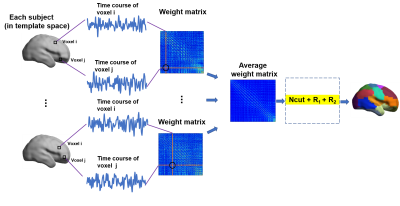 |
15 |
 Regularized-Ncut: Robust functional parcellation of brain networks Regularized-Ncut: Robust functional parcellation of brain networks
Qinmu Peng, Ouyang Minhui, Jiaojian Wang, Qinlin Yu, Chenying Zhao, Slinger Michelle, Hongming Li, Yong Fan, Bo Hong, Hao Huang
Human brain functional networks are critical in understanding intrinsic functional organization and systems. However, functional brain parcellation is affected by noise, resulting in artificial small patches and decreased functional homogeneity within certain networks. Using resting-state fMRI, we proposed a novel data-driven regularized-Ncut (RNcut) method by integrating a smoothing term and a small patches removal term to conventional Ncut for parcellating functional networks. The proposed method could delineate parcellated functional networks with higher functional homogeneity and better spatial contiguity with less noisy patches. A broad range of brain network applications and analyses could benefit from the proposed RNcut.
|
|
5549.
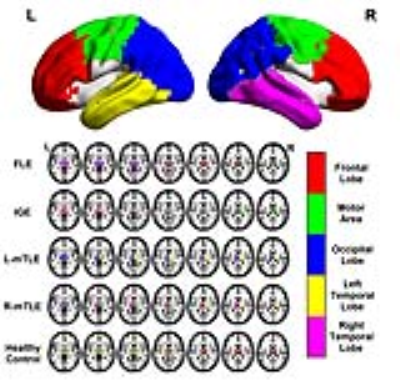 |
16 |
 Altered structural covariance corticothalamic networks in epilepsy. Altered structural covariance corticothalamic networks in epilepsy.
Qiang Xu, Qirui Zhang, Zhiqiang Zhang, Wei Quan, Junhao Xiao, Guangming Lu
It is the first work to depict the corticothalamus relationship by using the structural covariance connectivity. The epilepsy would significantly change the cortex-thalamus mode. The unilateral foci would lead the damage to the ipsilateral thalamus firstly. It provided a novel window to detected the mechanism of epilepsy.
|
|
5550.
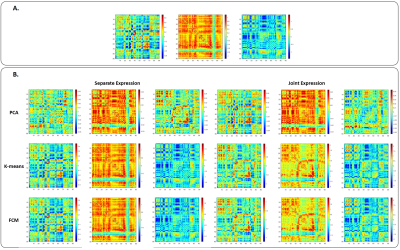 |
17 |
 Evaluation of fuzzy clustering for the identification of separate and joint dynamic functional connectivity patterns in resting-state fMRI Evaluation of fuzzy clustering for the identification of separate and joint dynamic functional connectivity patterns in resting-state fMRI
Margarida Solas, Rodolfo Abreu, Cátia Salgado, Susana Vieira, Patrícia Figueiredo
We propose to investigate the validity and applicability of fuzzy clustering (FCM) for the identification of dynamic functional connectivity (dFC) patterns in resting-state fMRI data, and comparing it with two approaches that have been used in this context (PCA and K-means). For such purpose, all methods were applied to data simulating either the joint or separate expression of dFC patterns, and to empirical data, collected from epilepsy patients. Both clustering methods, particularly FCM, outperformed PCA. Concomitantly, results from empirical data indicated that the occurrence of epileptic activity of patients was separately expressed by the dFC patterns.
|
|
5551.
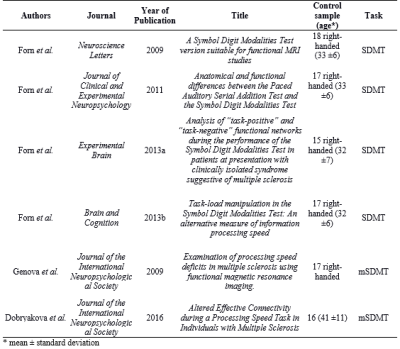 |
18 |
 A methodology to study brain specialization and integration during the information processing A methodology to study brain specialization and integration during the information processing
Pedro Henrique Rodrigues da Silva, Renata Ferranti Leoni
There is interest in understanding the functional integration of cognitive functions and effective therapeutic interventions as a strategy to improve cognitive deficits. However, uncertainty about how to proceed to address those issues remains. Therefore, this study aims to propose a methodology to assess brain specialization and integration during a cognitive task for future studies on the evaluation of therapeutic strategies. Our methodology provided a network model related to the performed task, that may serve as a reference for future investigations in clinical groups; and coupling parameters that may be used to evaluate the presence of adaptative neuroplasticity after cognitive training/rehabilitation.
|
|
5552.
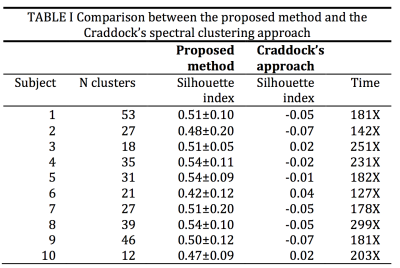 |
19 |
 Clustering-based identification of Regions-of-Interest in Functional Magnetic Resonance Images Clustering-based identification of Regions-of-Interest in Functional Magnetic Resonance Images
Camila Rojas, Alejandro Weinstein, Steren Chabert, Alejandro Veloz
The first step of brain network analysis in fMRI is to detect regions of interest. The signals from these ROIs are then used to evaluate neural networks and quantify neuronal dynamics The two main methods to identify ROIs are based on brain atlas registration and clustering. In this work, both paradigms are combined by using a hierarchical two-level approach. In the first level, the anatomical parcellation is applied and then a clustering-based strategy within anatomical labels is performed. The proposed method is compared with a current approach based on spectral clustering.
|
|
5553.
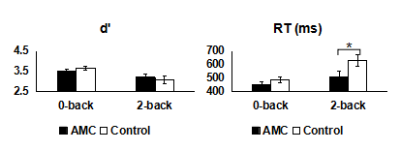 |
20 |
Enhanced task-related frontoparietal functional connectivity during a n-back task in children with abacus training
Did Not Present
Chunjie Wang, Feiyan Chen, Huafeng Liu
Abacus-based mental calculation (AMC) training has the potential to induce cognitive plasticity. However, the neural correlates of such benefits remain unknown. In this study, we aimed to examine impacts of AMC training on task-related functional connectivity. We obtained functional imaging data from 23 children with AMC training and 21 control children. For AMC children, we found a increase in task-related functional connectivity within the frontoparietal regions, which was also significantly correlated with the speed in the 2-back condition. Therefore, AMC training may enhance the functional integration of frontoparietal circuity, and consequently result in improved task performance.
|
|
5554.
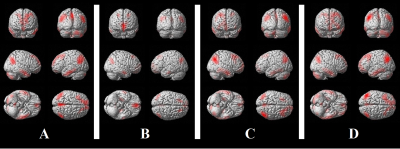 |
21 |
 DEFAULT MODE NETWORK MODIFICATIONS IN FABRY DISEASE DEFAULT MODE NETWORK MODIFICATIONS IN FABRY DISEASE
Sirio Cocozza, Giuseppe Pontillo, Mario Quarantelli, Francesco Saccà, Eleonora Riccio, Teresa Costabile, Gaia Olivo, Vincenzo Brescia Morra, Antonio Pisani, Enrico Tedeschi, Arturo Brunetti
We performed a Resting-State fMRI study to evaluate the integrity of the Default Mode Network (DMN) in Fabry Disease (FD), a condition in which neuropsychological symptoms are common and alterations of the functional connectivity (FC) have been recently reported. Compared to healthy controls FD patients showed clusters of increased FC involving different DMN hubs as well as the middle temporal gyri and the right cerebellum, with a significant correlation with the Corsi span test results (P=0.0001). Our results confirm the current view of a cerebral involvement in FD patients related to significant and diffuse functional changes.
|
|
5555.
 |
22 |
 Resting-State Functional Connectivity of the Language Network in Multiple Sclerosis in Young Adults Resting-State Functional Connectivity of the Language Network in Multiple Sclerosis in Young Adults
Andrew LaBella, Lauren Krupp, Leigh Charvet, Lev Bangiyev, Tim Duong
Multiple Sclerosis is affiliated with many clinical symptoms, including language deficiencies. However, the neural mechanism behind these problems hasn’t yet been explored. In this study, we use resting-state fMRI to probe the known language network in MS patients. We found that functional connectivity of the language network in MS patients is significantly correlated with clinical disability and results of a verbal learning test. Based on our results, we believe resting-state fMRI may be a viable tool to monitor language deficiencies in MS patients along with clinical scores.
|
|
fMRI: Other
Electronic Poster
fMRI
Thursday, 21 June 2018
| Exhibition Hall |
14:15 - 15:15 |
| |
|
Computer # |
|
5556.
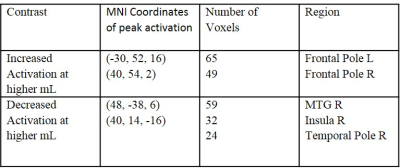 |
25 |
 Resting-State Fractional ALFF and Seed-Based Analysis as a Function of Bladder Discomfort Resting-State Fractional ALFF and Seed-Based Analysis as a Function of Bladder Discomfort
Andrew LaBella, Kenneth Wengler, Justina Tam, Sindhuja Govindarajan, Steven Weissbart, Tim Duong, Xiang He
The neural mechanisms underlying over active bladder are not fully understood. In addition, the neural network involved in bladder control hasn’t been identified. In this study, we looked at resting-state functional MRI of healthy females as a function of bladder filling, utilizing fractional amplitude of low frequency fluctuation (fALFF) and seed-based functional connectivity measures. Our results demonstrate modulated activation amplitude and functional connectivity throughout the brain, primarily characterized by increases in the anterior brain, furthering our understanding of bladder control and setting the foundation for additional higher level analyses.
|
|
5557.
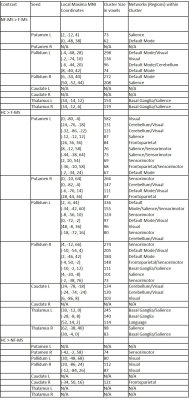 |
26 |
 Resting-State Functional Connectivity of Subcortical Grey Matter Correlates with Fatigue in Young Adults with Multiple Sclerosis Resting-State Functional Connectivity of Subcortical Grey Matter Correlates with Fatigue in Young Adults with Multiple Sclerosis
Andrew LaBella, Lauren Krupp, Leigh Charvet, Lev Bangiyev, Tim Duong
While striatal and thalamic networks have been linked with fatigue in MS, they haven’t been explored in any young adult MS population. Further probing is needed to fully understand the fatigue correlate in MS and how it compares with differences between healthy controls and MS patients. In this study, we compared resting state functional connectivity measures in healthy controls, fatigued, and non-fatigued MS patients. Our results demonstrate that fatigue correlates with deficits in subcortical connectivity with several resting state networks. We found overlap between certain MS-related and fatigue-related changes, providing further insight into MS pathology and its fatigue correlate.
|
|
5558.
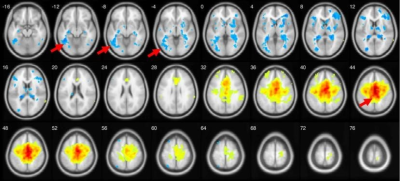 |
27 |
Application of fMRI with seed-based analysis for assessment of functional connectivity in patients with fragile X syndrome
Video Permission Withheld
Yulia Rymareva, Evgeny Petrovskiy, Andrey Savelov, Evgenia Isanova, Dmitry Yudkin, Alexandr Chupakhin, Andrey Tulupov
The purpose of the study was to find neurobiological correlates of cognitive disability in patients with fragile X syndrome using resting state fMRI and seed-based correlation analysis.
|
|
5559.
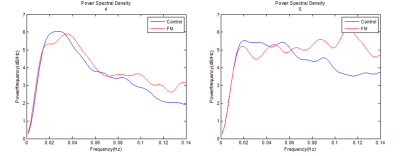 |
28 |
 Disrupted resting-state functional connectivity and low-frequency fluctuation in chronic pain Disrupted resting-state functional connectivity and low-frequency fluctuation in chronic pain
Woojin Choi, June Sic Kim, Chun Kee Chung
By applying dynamic functional connectivity and low-frequency fluctuation analysis of resting-state fMRI data, the present study investigated a disrupted intrinsic resting-state network in chronic pain patients.
|
|
5560.
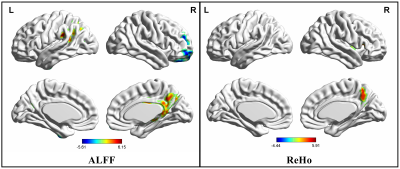 |
29 |
 Dynamic development of spontaneous neuronal activity in postpartum women: A longitudinal resting-state functional MRI study Dynamic development of spontaneous neuronal activity in postpartum women: A longitudinal resting-state functional MRI study
Kaihua Zhang, Mengxing Wang, Jilei Zhang, Haifeng Lu, Zhong Chen*, Xiaoxia Du*
Investigating the neuroanatomical and functional bases in postpartum women have contributed to understanding the processing of cognitive and emotional alterations. The objective of this study was to examine spontaneous neuronal activity and functional connectivity of resting-state networks in postpartum women using a longitudinal resting-state functional magnetic resonance imaging. Twenty-three postpartum women were recruited. Amplitude of low-frequency fluctuation (ALFF), regional homogeneity (ReHo) and functional connectivity were calculated to measure spontaneous neuronal activity and brain network. Results revealed that changes in resting state brain network might be dynamic development for adaptive changes including cognitive function and empathic processing in postpartum women.
|
|
5561.
 |
30 |
 Intra- and inter-scanner reliability of scaled subprofile model of principal component analysis in resting-state fMRI Intra- and inter-scanner reliability of scaled subprofile model of principal component analysis in resting-state fMRI
Li-Xia Yuan, Jian-Bao Wang, Na Zhao, Yuan-Yuan Li, Dong-Qiang Liu, Hong-Jian He, Jian-Hui Zhong, Yi-Long Ma, Yu-Feng Zang
Scaled subprofile model of principal component analysis (SSM-PCA) is a multivariate statistical method, widely used in positron emission tomography (PET). Recently, SSM-PCA has been applied to resting-state functional MRI (RS-fMRI). However, the intra- and inter-scanner reliability of SSM-PCA in RS-fMRI is not investigated systematically yet. Results from eyes-open (EO) and eyes-closed (EC) dataset demonstrate that both the intra- and inter-scanner reliability is excellent for EO and EC related covariance pattern (EOEC-pattern) and fair to good for EOEC-pattern’s expression. Moreover, SSM-PCA and conventional T-test are complementary for neuroimaging researches. This study illustrates the great potential of SSM-PCA for further applications in RS-fMRI.
|
|
5562.
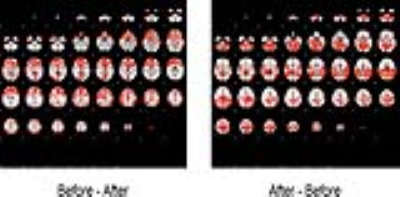 |
31 |
 Impact of Carotid Endarterectomy on Functional Connectivity Impact of Carotid Endarterectomy on Functional Connectivity
Marc Lindley, Adam Bernstein, Chidi Ugonna, Denise Bruck, Kevin Johnson, Maria Altbach, Lee Ryan, Nan-kuei Chen, Ying-hui Chou, Gloria Guzman, Theodore Trouard, Craig Weinkauf
Carotid endarterectomy (CEA) as a procedure has been shown effective in reducing the risk of stroke for patients with severe stenosis. The impact of CEA on the functional connectivity of the brain has not been assessed to this point. Nine patients underwent resting state fMRI pre-operatively and 1 month and 6 months post-operatively. Analysis was performed using seed based analysis and matrix based analysis to determine if there were functional connectivity changes as a result of CEA. Seed based and matrix based analysis showed that there were significant functional connectivity changes as result of CEA.
|
|
5563.
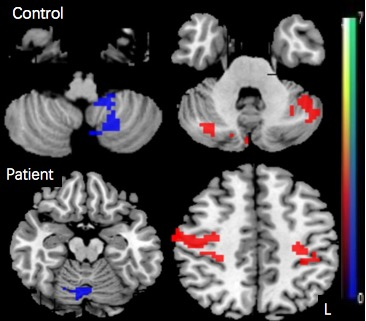 |
32 |
 Altered functional connectivity between cerebral and cerebellar resting-state networks in autism spectrum disorder Altered functional connectivity between cerebral and cerebellar resting-state networks in autism spectrum disorder
Yan Wang, Wenjing Zhang, Zheng Wang, Jieke Liu, John Sweeney, Stormi White, Su Lui, Matthew Mosconi
By examining the correlation between motor data and brain resting-state functional imaging and identifying the functional connectivity alteration in ASD using a seed-driven approach, individuals with ASD demonstrate altered pattern of motor activation and diffusely decreased FC within frontal-subcortical-cerebellar circuit and within cerebellar network, which may represent the underlying neurobiological mechanisms of motor dysfunction and further delayed acquisition of gestures important for socialization and communication.
|
|
5564.
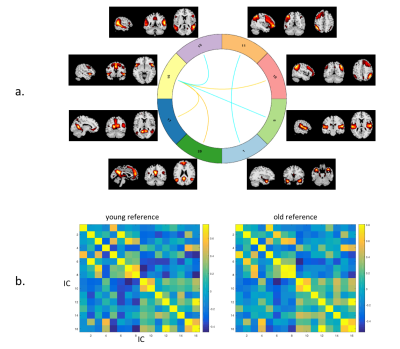 |
33 |
 The Effect of HIV and Aging on Functional Connectivity, Connectome Similarity, and Structural changes The Effect of HIV and Aging on Functional Connectivity, Connectome Similarity, and Structural changes
Yuchuan Zhuang, Lu Wang, Madalina Tivarus , Xing Qiu, Jianhui Zhong, Giovanni Schifitto
We investigated the effect of HIV-infection and aging using resting-state fMRI and T1-weighted structural images. First, we assessed the inter-network functional connectivity and identified 8 resting-state networks associate with normal aging. Second, we constructed a functional connectome similarity as a global measure of neural connectivity pattern to assess the effect of age and HIV infection. Lastly, we measured cortical thickness and brain volumetrics. We found a significant effect of aging but not a definite additive or synergistic effect of HIV infection in all three analyses.
|
|
5565.
 |
34 |
 Creativity Performance Reflected on the Activation of Divergent Thinking and Connectivity of Inferior Frontal Gyrus Creativity Performance Reflected on the Activation of Divergent Thinking and Connectivity of Inferior Frontal Gyrus
Hong-Yu Wu, Bo-Cheng Kuo, Chih-Mao Huang, Jyh-Horng Chen, Changwei Wu
Creativity is taken as a spontaneous mental process and creativity scales associates with resting-state functional connectivity in literature. However, it remains unclear that how brain integrity changes following creative thoughts. Targeting on this causal effect, we explored the functional connectivity before and after the engagement of divergent thinking. We demonstrated the interactions between brain activations in divergent thinking and functional connectivity in certain networks, especially in the locus of left inferior frontal gyrus (IFG). Meanwhile, the reduced IFG-precuneus connections could benefit the creativity performances.
|
|
5566.
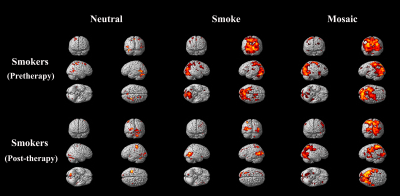 |
35 |
fMRI-measured brain responses to smoking-related images before and after smoking cessation treatment by varenicline
Did Not Present
Peng Peng, Li Chunlin, Jing Bin, Chu Shuilian, Jiang Tao
This study investigated the activation of brain regions to visual smoking cues in smokers before and after cessation treatment using an event-related design fMRI. The result demonstrated that smokers will have good tolerance to smoking-related stimuli after using varenicline. This may explain why the curative effect of varenicline is better than NRT which has been related to an increased the brain response. The results provide further evidence for medication choice of clinicians for smoking cessation.
|
|
5567.
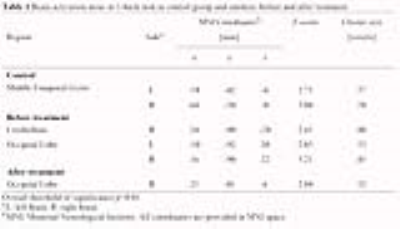 |
36 |
Effects of smoking cessation treatment on cognition of smokers by using varenicline: a fMRI study
Did Not Present
Peng Peng, Li Chunlin, Jing Bin, Chu Shuilian, Jiang Tao
This study investigated the working memory-related brain activity to 3 different difficulty level n-back task before and after cessation treatment. Brain activation increased with increasing task difficulty in both control and smoker groups. The brain activation of smokers was higher than that of the control group, but the activation degree of smoking cessation treatment group was significantly lower than that before treatment, which was close to that of the control group. The result demonstrated varenicline’s cure effect on improving cognitive function, which was important to improve the withdrawal symptoms and increase smoking cessation rate.
|
|
5568.
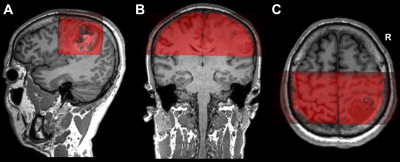 |
37 |
 The application of ZOOMit-BOLD for motor function localization in glioma The application of ZOOMit-BOLD for motor function localization in glioma
Shengyu Fang, Tianyi Qian, Yinyan Wang, Tao Jiang
ZOOMit blood oxygen level dependent fMRI (ZOOMit-BOLD) can excite only a small field of view using simultaneous parallel radiofrequency pulse sequences. It provides high spatial resolution while minimizing aliasing artifacts. This prospective study compared the clinical performances of ZOOMit-BOLD and conventional-BOLD in pre-surgical hand motor function localization. Compared with conventional EPI-based BOLD acquisition, ZOOMit-BOLD is a reliable technology with higher accuracy in preoperative motor functional localization in clinical patients with gliomas, particularly when the glioma directly invades the primary motor cortex.
|
|
5569.
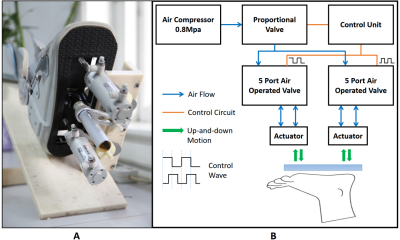 |
38 |
 Novel MRI-compatible foot-sole stimulator for characterizing the cortical regions pertaining to walking-related somatosensory perception Novel MRI-compatible foot-sole stimulator for characterizing the cortical regions pertaining to walking-related somatosensory perception
Tingwei Zhang, Kai Zhang, Yufeng Chai, Yunfei Long, Xiaoying Wang, Junhong Zhou, Brad Manor, Lewis Lipsitz, Jue Zhang, Jing Fang
The decline of foot-sole somatosensation is one of the main contributors to diminished balance of walking. The response of brain regions to the inputs from foot-soles is critical to the somatosensory perception, which, however, remains unknown. Here we developed a dual-drive stimulator applying pressure stimuli that mimic those as experienced during walking on the feet. This stimulator is compatible for MRI and the foot-sole pressure stimuli significantly increases the excitability (i.e., BOLD signal intensity) within multiple brain regions. This stimulator may thus be a novel tool to characterize the brain’s responsiveness in the perception of foot-sole somatosensation pertaining to walking.
|
|
5570.
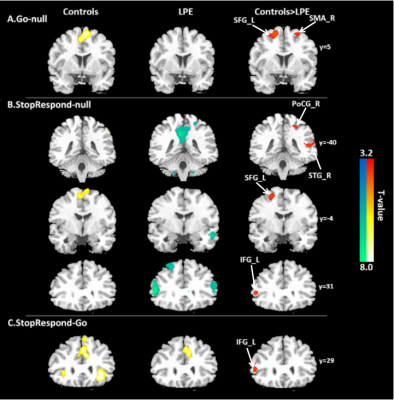 |
39 |
Brain response to stop signal task in lifelong Premature Ejaculation patients compared to healthy subjects
Did Not Present
Lan Zhang, Xuejuan Yang, Ming Gao, Lin Liu, Peng Liu, Jinbo Sun, Wei Qin, Jie Tian
Life-long premature ejaculation (LPE) is a common male sexual dysfunction. Previous studies revealed ejaculation-related control mechanisms in the brain. However, whether this control network changes in patients with LPE is unclear. A stop signal test was used in this study. A study of task-related functional MRI found there was a significant difference in neural network activation between healthy controls and LPE patients during go process. This study indicates a neural network abnormality in LPE patients, which provides novel reference for understanding the neural mechanism of LPE.
|
|
5571.
 |
40 |
 T1-dispersion curves modelling and analysis of human glioma resections: a novel biomarker of molecular dynamics T1-dispersion curves modelling and analysis of human glioma resections: a novel biomarker of molecular dynamics
Manuel Petit, Sandra Pierre, Maxime Leclerq, Pascal Fries, François Berger, Lionel Broche, Hana Lahrech
Here we aim to characterize human glioblastoma with FFC-NMR using cerebral tissue of normal pig as a reference. Power-law models and Fries-Belorisky model (quadrupolar 14N-1H coupling peaks (QPs)) were used to analyse the T1-dispersion. Linear Discriminant Analysis and statistical tests of derived fit parameters were used for classification. T1 values at low field were found significantly different between cerebral tissues and glioblastoma, a result which is well admitted by the NMR community. However our most relevant finding is the role of the molecular dynamics related parameters to discriminate glioblastoma from cerebral tissues. QPs parameters also appear as a possible biomarkers but require higher signal sensitivity.
|
|
5572.
 |
41 |
 FFC-NMR: A promise tool to discriminate infiltrative tumour cells from solid tumours: a study of three glioma mouse models FFC-NMR: A promise tool to discriminate infiltrative tumour cells from solid tumours: a study of three glioma mouse models
Manuel Petit, Sandra Pierre, Maxime Leclerq, Pascal Fries, François Berger, Lionel Broche, Hana Lahrech
Using Fast-Field Cycling NMR (FFC-NMR), three glioma mouse models were studied to compare T1-dispersion curves of solid tumours (U87) versus infiltrative tumours (Glio6 and Glio96). The U87 T1-dispersion curves were found distinct from those of Glio6 and Glio96 and fitted well to the power-law model (1/T1=γ/2π B0β). Statistical tests were used to find which model parameters discriminate the two tumour types. Results confirm the interest of low magnetic fields to exploit the offset parameter A, which corresponds to relaxation T1, but specifically highlight the interest of the low-field exponent βL parameter which give a molecular dynamic information, that is invisible by conventional NMR methods.
|
|
5573.
 |
42 |
 Alterations of regional homogeneity in poststroke aphasia Alterations of regional homogeneity in poststroke aphasia
Hui Zhang, Ying Chen, Ruiping Hu, Liqing Yang, Mengxing Wang, Jilei Zhang, Yi Wu, Xiaoxia Du*
The purpose of this study was to investigate intrinsic local synchrony changes in poststroke aphasia patients during resting-state fMRI scans. Fifteen patients (aged, 39-62 years, 4 female) and 30 age- and gender-matched healthy controls participated. Regional homogeneity (ReHo) was calculated to measure spontaneous brain activity. The results showed that poststroke aphasia patients exhibited significantly increased ReHo in the left frontal lobe, left cingulate gyrus, left corpus callosum, left temporo-parietal areas and right middle frontal gurus. Our study showed patterns of intrinsic local synchronization are altered in poststroke aphasia patients at resting state.
|
|
5574.
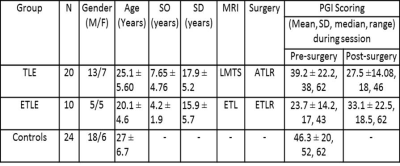 |
43 |
Semantic verbal memory outcome in TLE and ETLE patients after surgery using fMRI
Video Permission Withheld
Kapil Chaudhary, Senthil Kumaran, P Sarat Chandra, Ashima Nehra, Manjari Tripathi
Memory can be broadly classified as sensory (process > 1 second), short term (>1 minute) and long term encoding in which information is encoded, stored, and retrieved. The surgical planning in drug refractory epilepsy (DRE) patients is usually associated with memory deficits. We measured BOLD activation during semantic verbal memory task using auditory stimulus and correlation with clinical parameters in patients (pre and 6 month of post-surgery) and controls. Study revealed anterior temporal lobe resection (ATLR) including removal of medial structures surrounding anterior temporal lobe may develop memory deficits in left TLE patients.
|
|
5575.
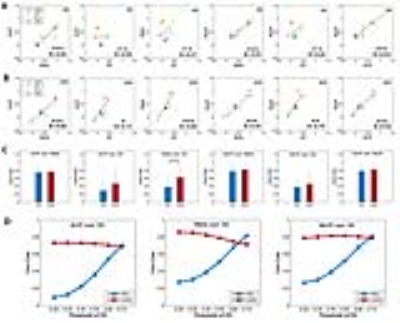 |
44 |
 Coupled temporal variation and global functional connectivity density of spontaneous brain activity in self-hypnosis for respiratory motion control Coupled temporal variation and global functional connectivity density of spontaneous brain activity in self-hypnosis for respiratory motion control
Yanjun Liu, Rongmao Li, Yaoqin Xie
This study aims to explore the correlative relationship between temporal variation and signal synchronization of spontaneous brain activity in self-hypnosis for respiratory motion control and relaxation. A resting-state fMRI was employed to an intra-subject of 15 hypnotist volunteers in rest state and self-hypnosis state to explore the inter-state difference of correlation within four conventional resting-state networks. The results demonstrated that coupled temporal variation and signal synchronization of brain activity in self-hypnosis. It provides neural implications of self-hypnosis, a psychological technology that can generate positively psychological and physiological effects, in controllable self-regulation, which is beneficial to cancer patients during radiotherapy.
|
|
5576.
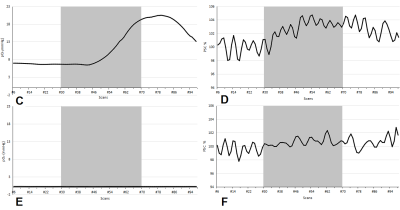 |
45 |
 Verifying the Reliability of Steady-State Free Precession fMRI in Detecting Oxygen Saturation Changes in Rat C6 Glioma Verifying the Reliability of Steady-State Free Precession fMRI in Detecting Oxygen Saturation Changes in Rat C6 Glioma
Hao Chen, Junwei Zhang, Zhen Jiang, Jin Xu, Qiqi Chen, Siying Wang, Junkang Shen
In this study, we aim to verify the reliability of steady-state free precession (SSFP) technique for detecting oxygen saturation level changes in functional MRI (fMRI). We compared SSFP fMRI image signals in rat glioma with pO2 values measured directly using MRI compatible fiber-optic microprobes, and we found that their temporal variations resembled each other. Therefore, SSFP fMRI, as a non-invasive imaging technique, can be used to reveal the location of re-oxygenation hence hypoxia in tumor.
|
|
5577.
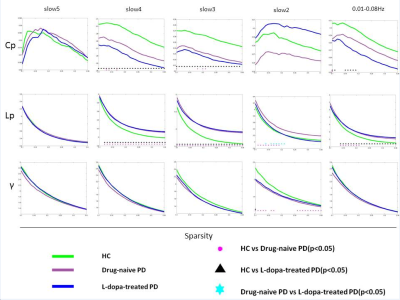 |
46 |
Intrinsic Frequency Specific Brain Networks of Parkinson's Disease Patients
Did Not Present
Xuemei Fu
The majority of previous studies concerning the brain network derived from resting state fMRI focused on a low frequency of signal oscillation from 0.01 to 0.1 Hz (Bullmore and Sporns 2009; Van Den Heuvel and Hulshoff Pol 2010). However, the frequency specificities with regard to the topological properties of the PD brain networks have not been fully revealed. To exam the frequency properties of Drug-naive and L-dopa-treated Parkinson's Disease Patients, we subdivided the low frequency range into five bands as previously defined (Biswal et al., 1995; Buzsáki and Draguhn, 2004; Penttonen, 2003). The results suggest that the subdivided frequency bands prominently dissociate topological organisation of brain networks between drug-naive PD patients and L-dopa- treated PD patients.
|
|
5578.
 |
47 |
 BOLD activation pattern of cerebrum for unilateral and bilateral wrist extension task among stroke patients and healthy subjects BOLD activation pattern of cerebrum for unilateral and bilateral wrist extension task among stroke patients and healthy subjects
Neha Singh , Dixit Sharma , Megha Saini , Sneh Anand , Nand Kumar , MV Padma Srivastava , S Senthil Kumaran , Amit Mehndiratta
Role of wrist-extension in motor control in upper-limb post-stroke recovery is significant. We compared neural structures controlling unilateral versus bilateral movement of wrist-extension task using fMRI in 6 healthy-volunteers and 6 stroke-patients. Significant BOLD activation was observed in PG during all three tasks in healthy-volunteers. Activation with bilateral-task were considerably higher than unilateral-task. In patients with stroke as a result of re-organization, ipsi-lesion cerebellum-area shows activation for affected-hand movement not present in healthy-volunteers, supporting evidence for advantages of bilateral-training in functional imaging. Knowledge of reorganization-pattern for coordinated-movement involved in bilateral-tasks may be helpful in addressing the rehabilitation of stroke-patients.
|
|
5579.
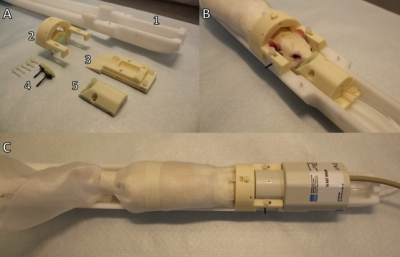 |
48 |
 Awake rat functional magnetic resonance imaging using 3D printed restrainment kit and standard RF-coils Awake rat functional magnetic resonance imaging using 3D printed restrainment kit and standard RF-coils
Petteri Stenroos, Jaakko Paasonen, Raimo Salo, Kimmo Jokivarsi, Olli Gröhn
Anesthetics are typically used in preclinical functional magnetic resonance imaging (fMRI) experiments to prevent animal movement and stress, but anesthetics can significantly affect the brain function. Therefore, several awake fMRI protocols have been developed, usually implementing house-made coils and holders. In present study, we developed a 3D printable restrainment kit that is compatible with standard Bruker rat coils and holders. Subsequently, resting state functional connectivity (RSFC) data was obtained under awake, lightly sedated, and anesthetized conditions. Our results show that even subanesthetic dose of isoflurane modulates FC significantly.
|
|
| Back |
| The International Society for Magnetic Resonance in Medicine is accredited by the Accreditation Council for Continuing Medical Education to provide continuing medical education for physicians. |































































































